Hue – Vietnam’s Royal City
The Adventures Abroad tour of Vietnam continues to go from one highlight to another with the last two stops Hoi An and My Son both being UNESCO World Heritage Sites. Well the hits just keep on coming as we head for our third World Heritage Site in a row, the former royal city of Hue. While I wasn’t very knowledgable about Hoi An and My Son in advance of visiting them, the same cannot be said about Hue which I have been looking forward to since the trip began. It has its own Forbidden City and while I haven’t been to the more famous one in Beijing, Alison has and she is looking forward to comparing the two. So please join our merry band of travellers in the city of Hue.
The distance from Hoi An to Hue is only about 126 kms. (78 miles), but it takes longer than you might think. First you must first pass by the city of Da Nang and then cross over the Ha Van Pass which crosses the only place in Vietnam where the mountains come right down to the sea. It has long acted as a natural dividing line between north and south Vietnam, but today is more renowned for the beautiful vistas that can be seen while traversing the pass.
This short You Tube video shows why it is considered one of the best coastal drives on earth. We were fortunate enough to have clear weather during our crossing and enjoyed it immensely.
On the other side of the pass we descended back to sea level and stopped for lunch at one of the most interesting seafood restaurants I’ve ever had the pleasure to dine at, Minh Tam in the village of Phu Loc.

You knew the fish was fresh because it was swimming right in front of you. This was a spotted grouper which was one of at least twenty varieties of live fish.
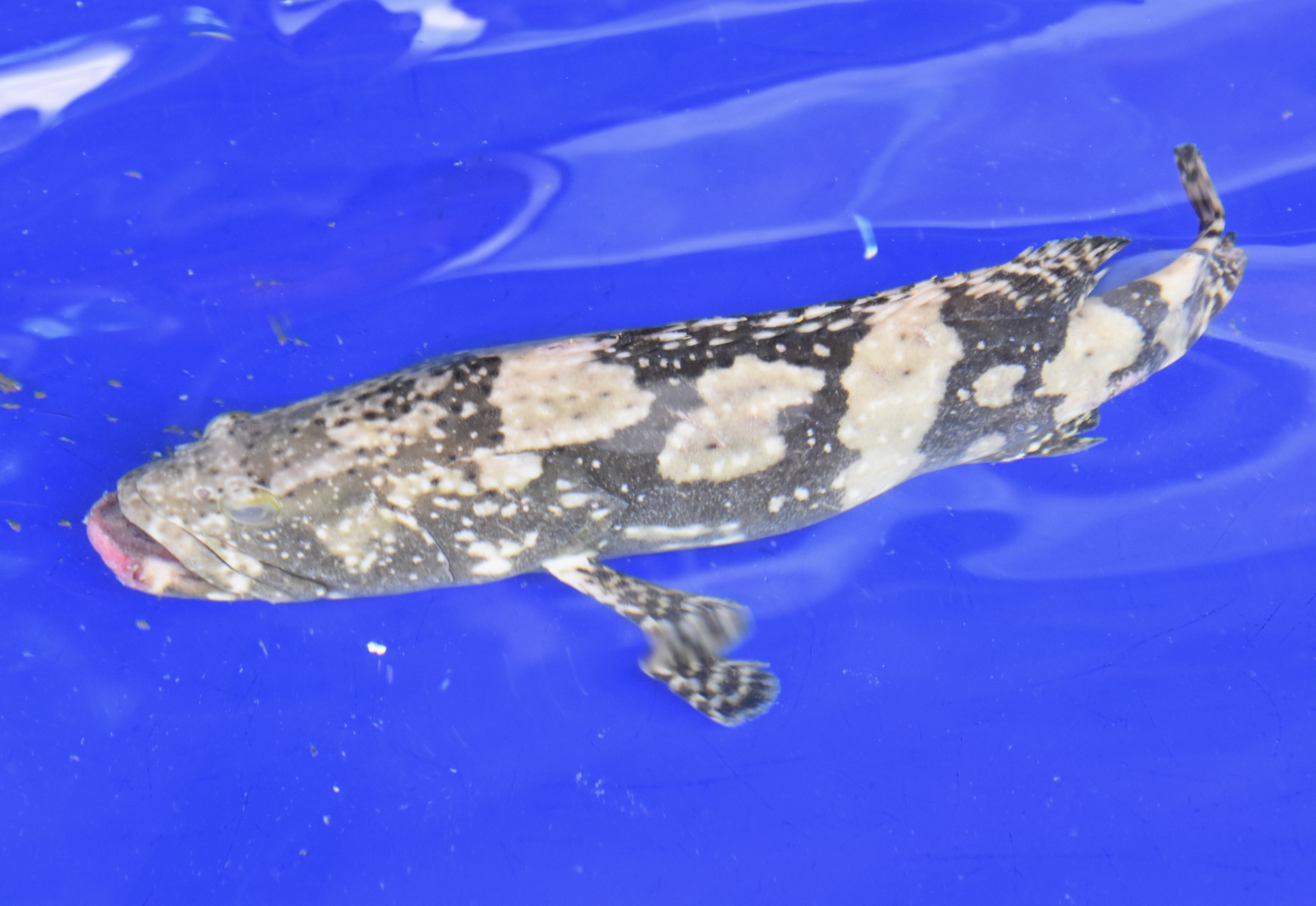
There were even more varieties of shellfish.
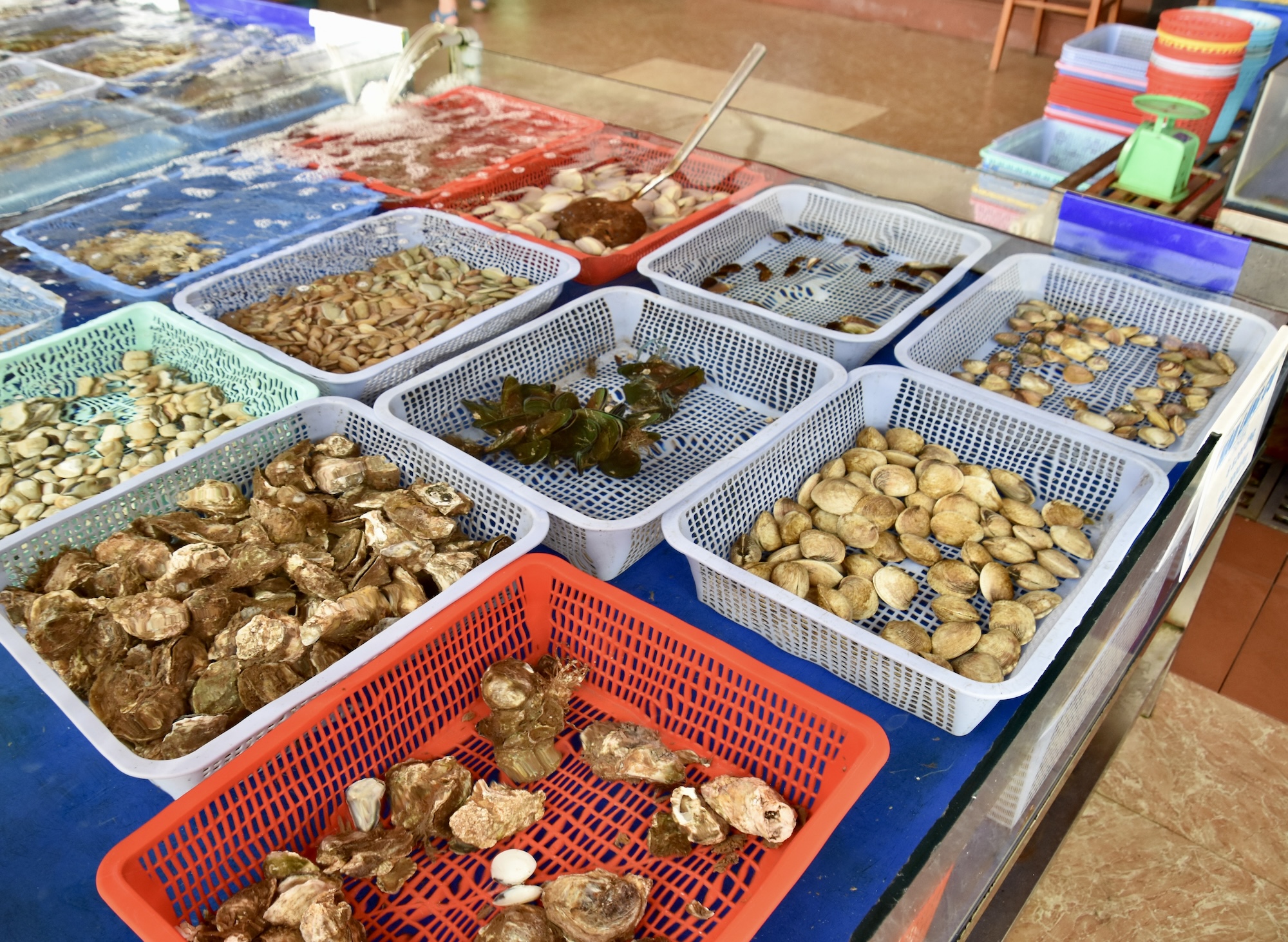
Needless to say our group was well fed and well contented as we shared a number of seafood items.
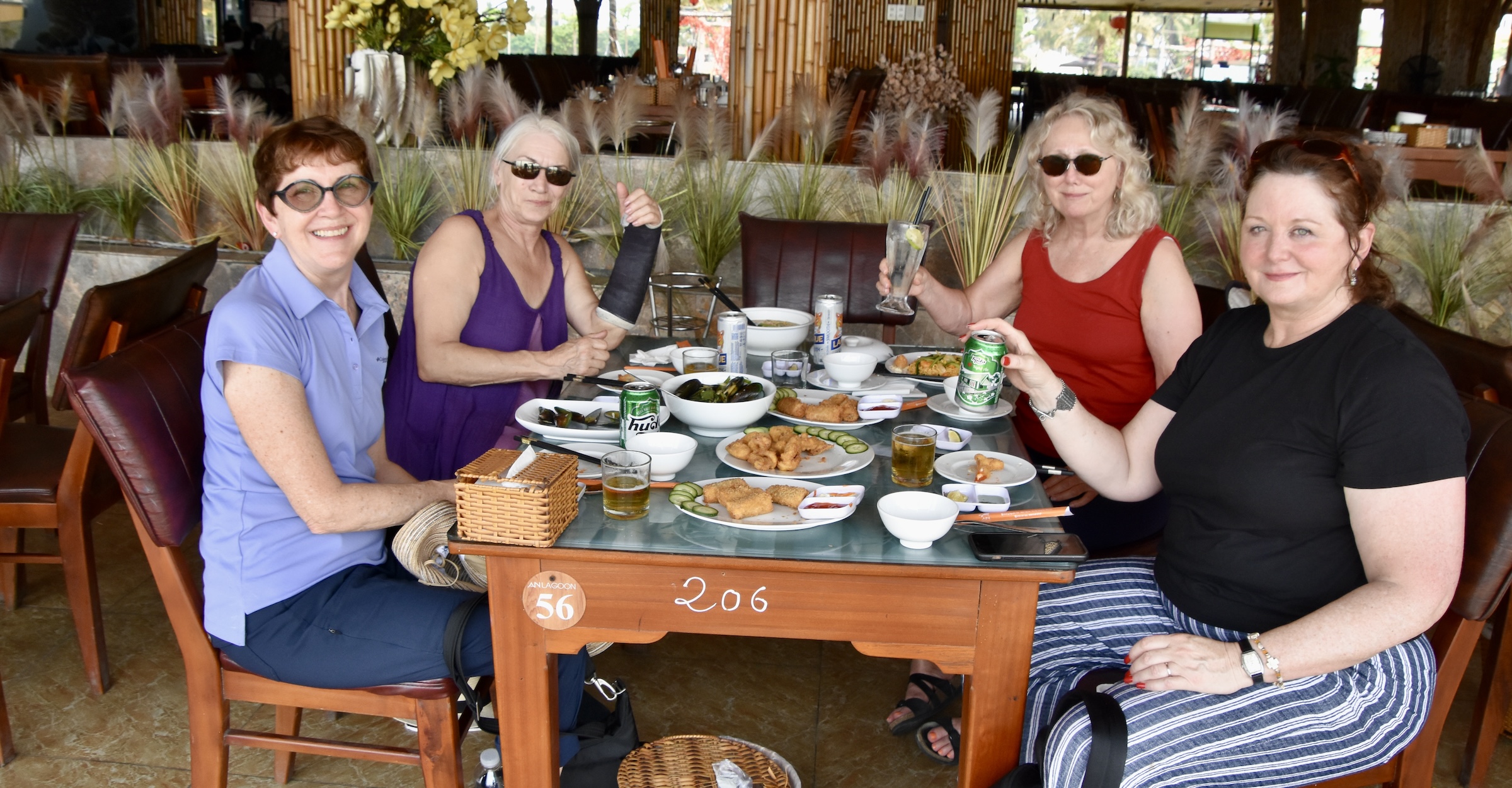
But I wasn’t sharing this fabulous pho with anyone.
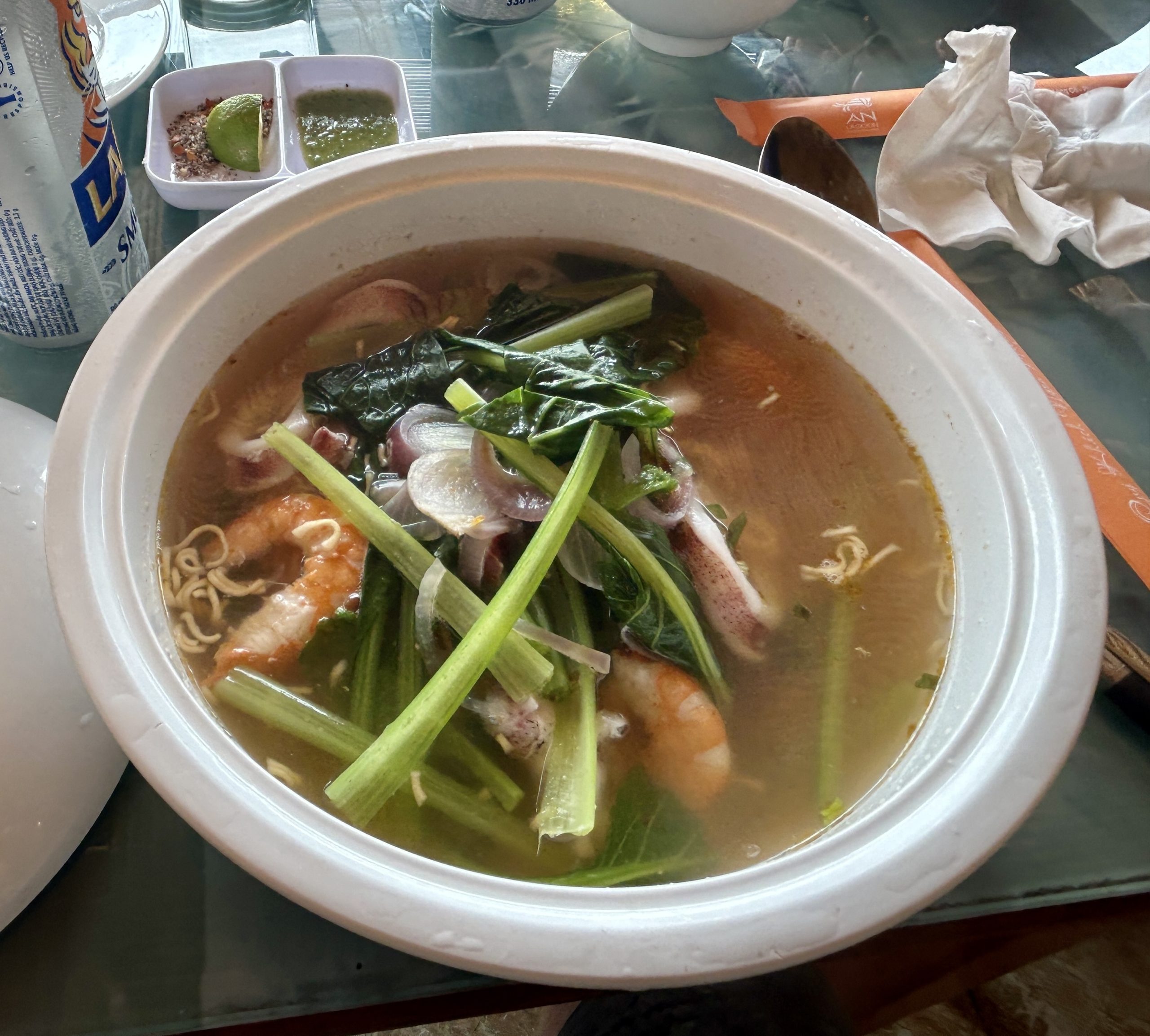
Before arriving in Hue we passed by a number of very photogenic Vietnamese fishing villages.
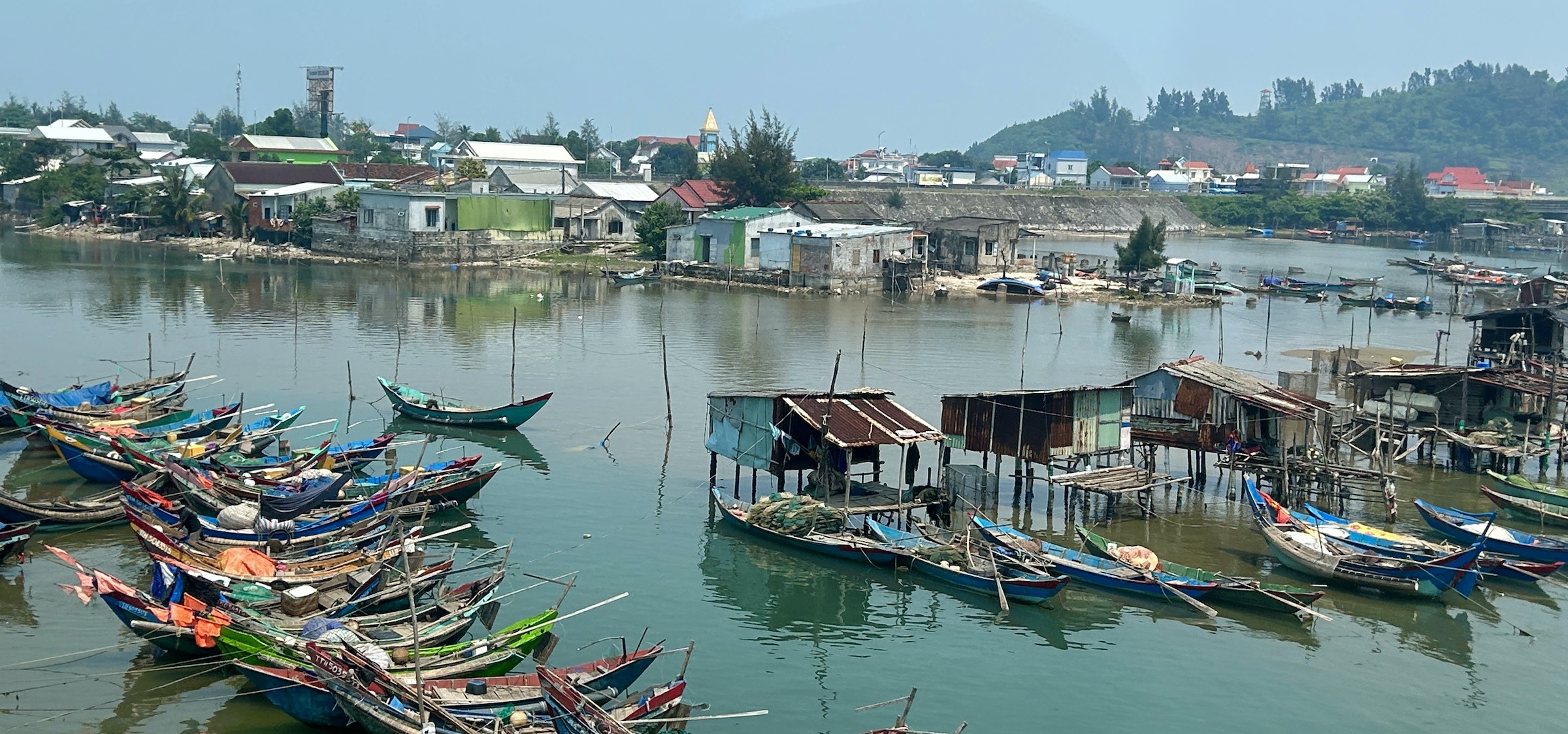
Heading into the city I noted that there is actually a real White Lotus Hotel, but this one didn’t look anywhere near as appealing as the fictional ones.
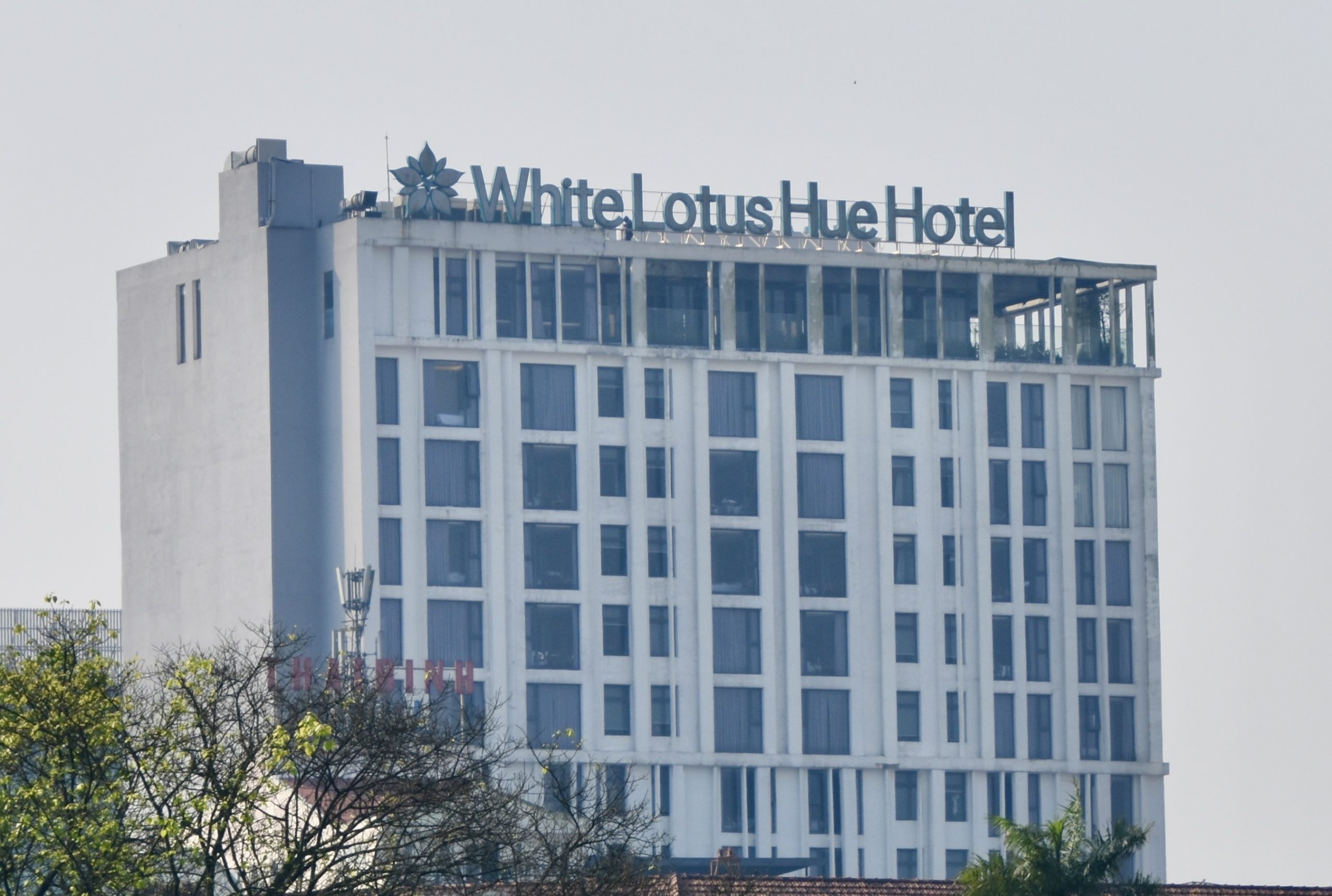
Or as nice as the Romance Hotel which was our base in Hue.

History of Hue
By Vietnamese standards Hue is not that old and until 1306 was included as part of the Champa Empire when the Champa king offered this part of central Vietnam to the Vietnamese rulers of everything north of that point in exchange for a marriage alliance – essentially a peace treaty. There followed almost three hundred years of constant infighting between various Vietnamese war lords that only ended when the Nguyen clan secured control of the area and began work on the first citadel at what later became Hue. In 1744 Hue became the capital of central and southern Vietnam, the Champa Empire by then having been supplanted by the Vietnamese. Between 1771 and 1802 the city became a pawn in a game of feuding war lords and changed hands multiple times until the Nguyens once again seized control of not only Hue, but all of Vietnam, the first time the country as we know it today was controlled by one entity.
Hue was named the national capital and remained so until the end of WWII, including the period of French rule from the late 1880’s onward. During this time the Emperors of Vietnam created the Imperial City as the seat of their power, including an inner Forbidden City. It is this complex along with its location on the banks of the Perfume River that got Hue inscribed as a UNESCO World Heritage Site in 1993 with this description:
The Complex of Hue Monuments is located in and around Hue City in Thua Thien-Hue Province in the geographical centre of Vietnam and with easy access to the sea. Established as the capital of unified Vietnam in 1802 CE, Hue was not only the political but also the cultural and religious centre under the Nguyen Dynasty, the last royal dynasty of Vietnamese history, from 1802 to 1945 CE.
The plan of the new capital is in accordance with ancient oriental philosophy, and respected the physical conditions of the site.
The Ngu Binh Mountain (known as the Royal Screen) and the Perfume River, which runs through the city, give this unique feudal capital an entire setting of great natural beauty as well defining its symbolic importance. The site was chosen for a combination of natural features – hills representing a protective screen in front of the monuments or taking the role of “a blue dragon” to the left and “a white tiger” to the right – which shield the main entrance and prevent the entry of malevolent spirits. Within this landscape, the main features of the city are laid out.
I’ve often commented upon the many methods of transportation that AA uses during its trips and our tour of Hue gets off to a start by being transported in pedi-cabs from the hotel to the Perfume River.
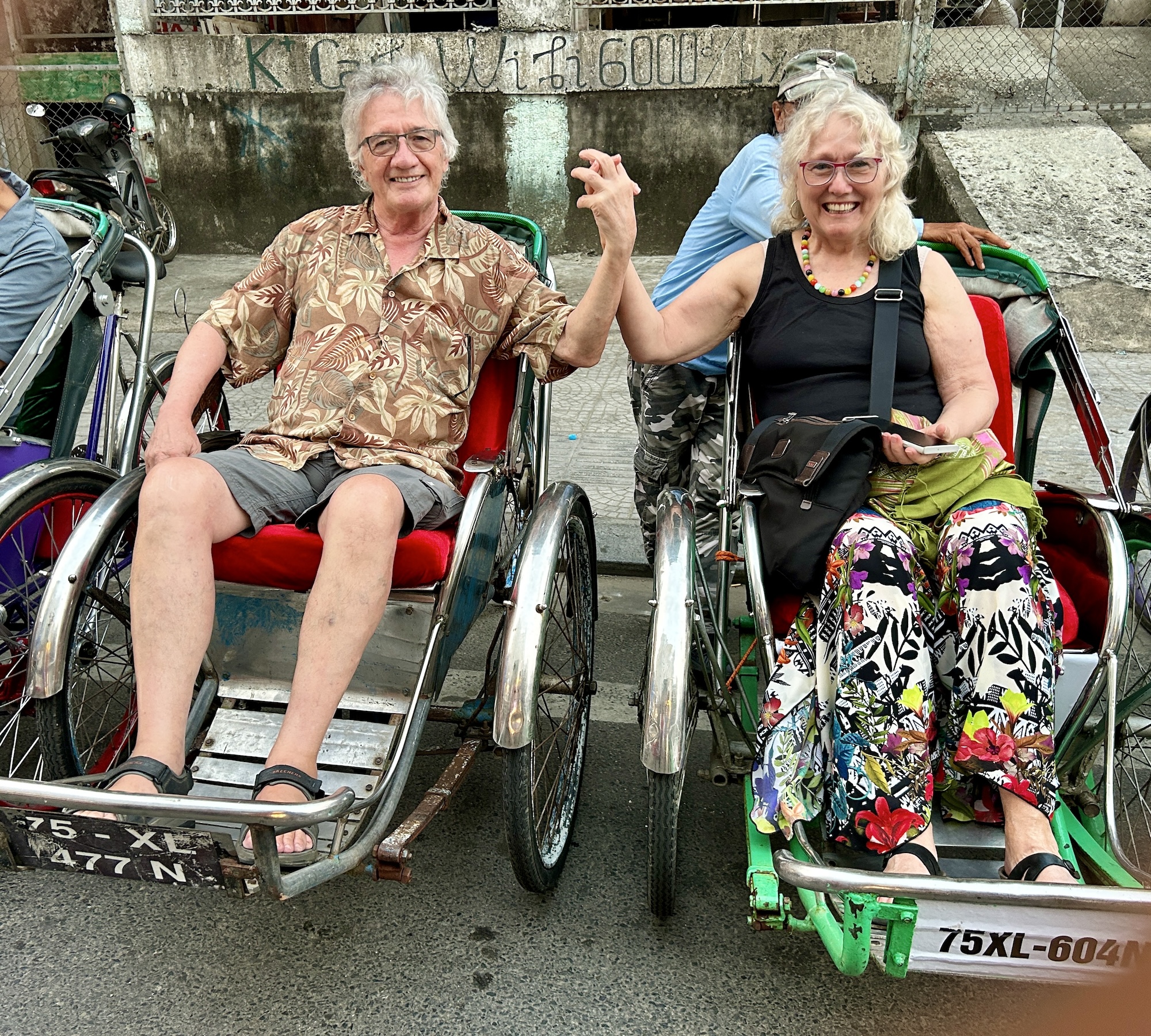
Here is the group making its way through the busy streets of Hue. It sounds a bit inane, but I love these type of experiences.
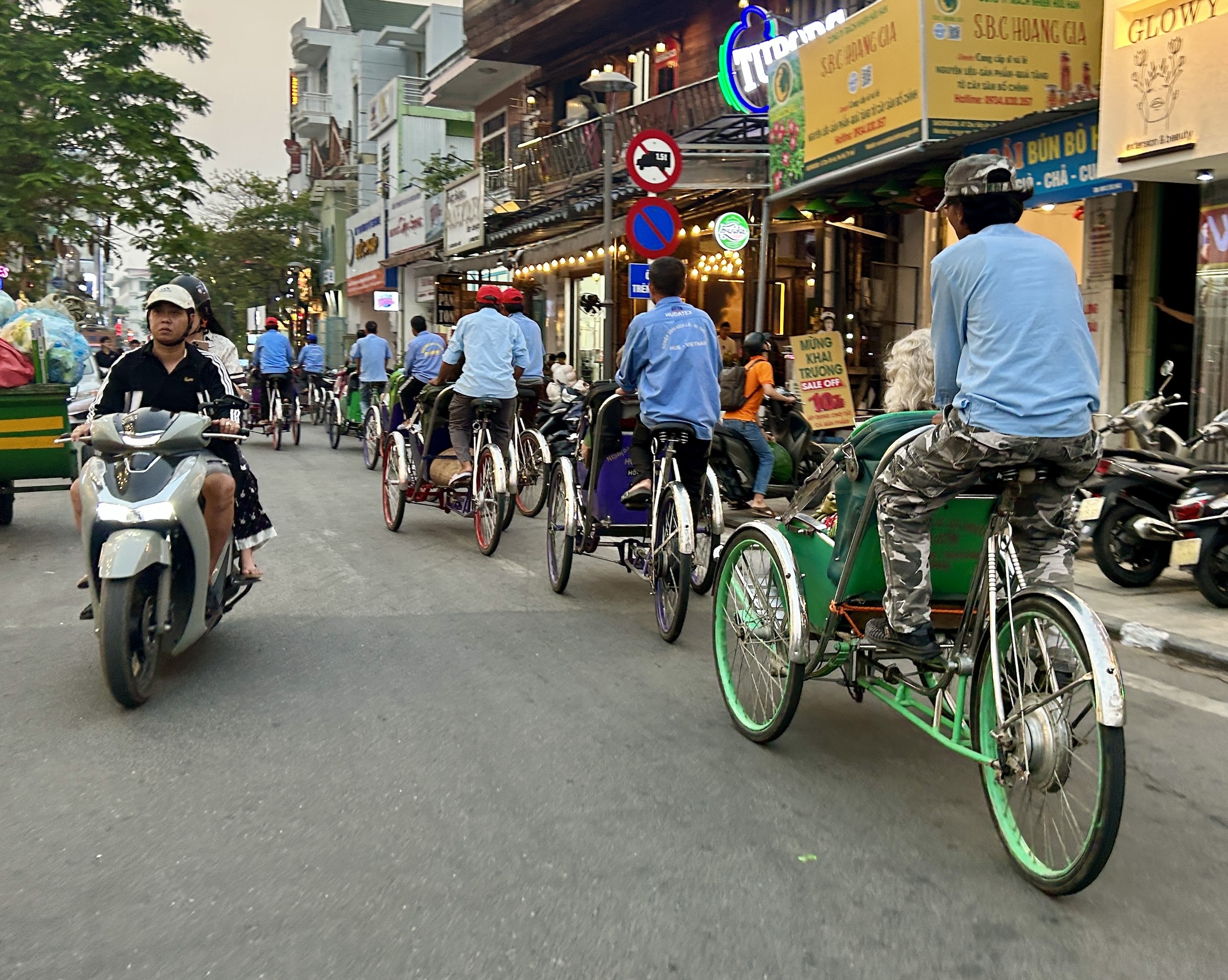
From the pedi-cabs we will take a private dragon boat up the Perfume River to the Perfume Pagoda. These are family owned businesses with the families usually living on board.
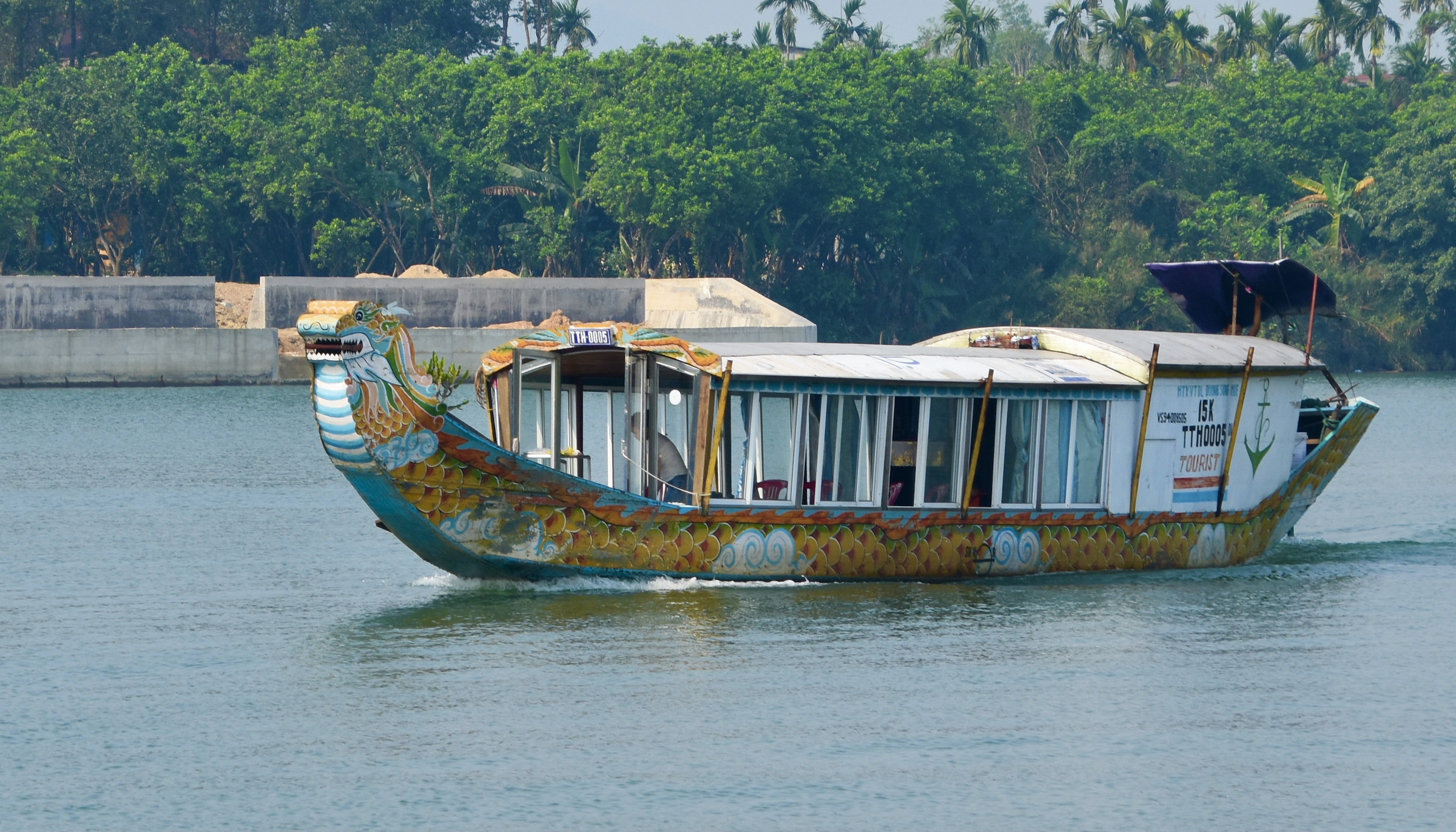
It is a completely peaceful morning on the river with dragon boats taking passengers in both directions.
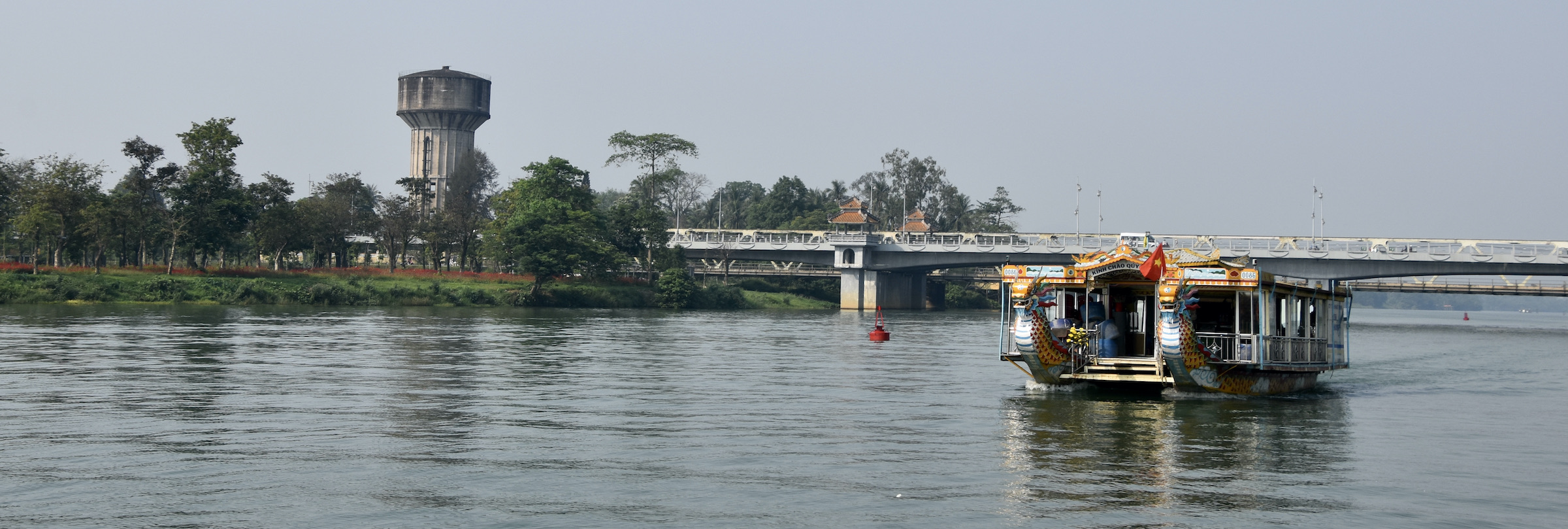
The Perfume Pagoda
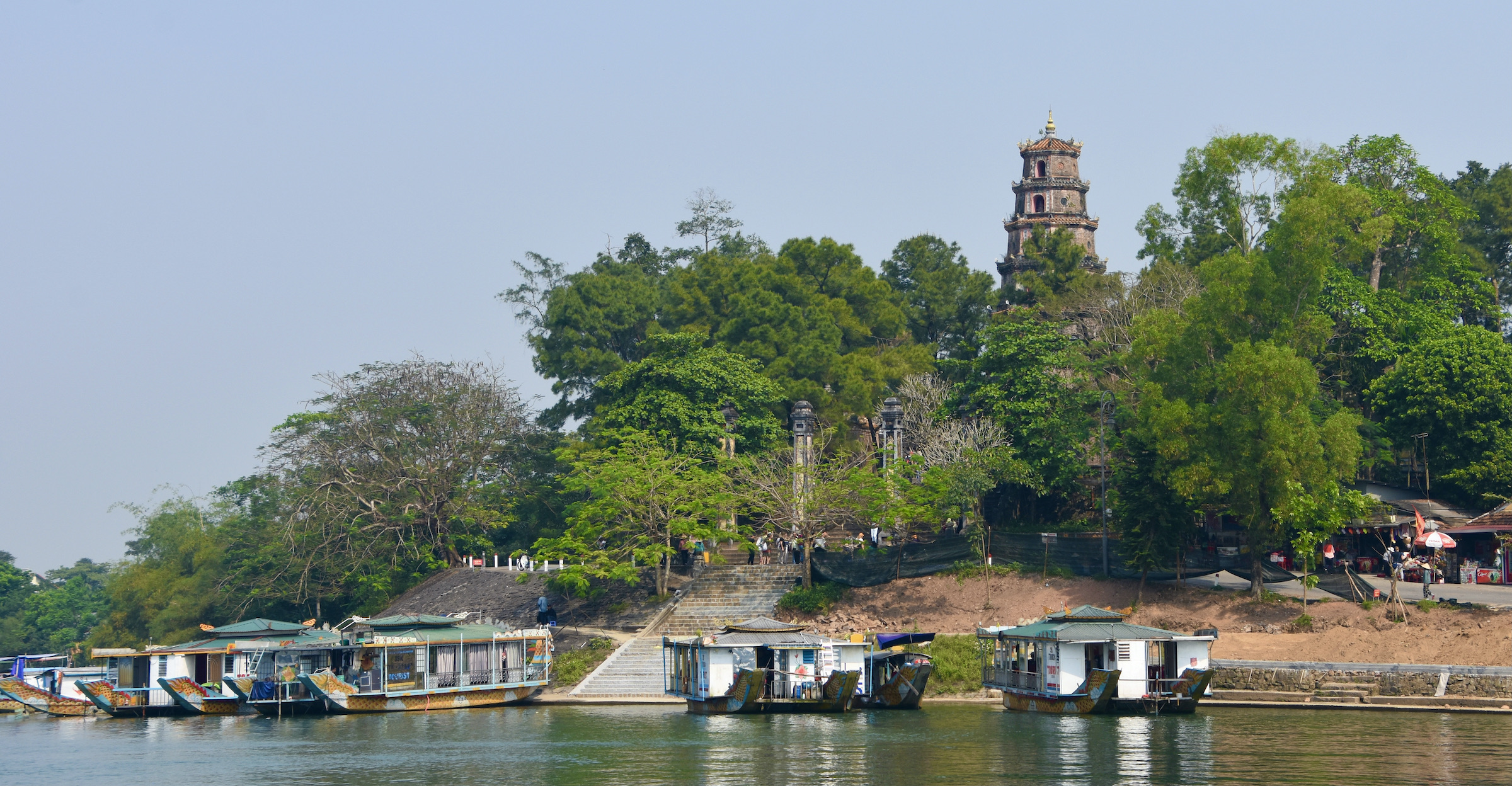
Thiên Mu Temple, aka the Perfume Pagoda, was built in 1601 by one of the first Nguyen rulers on a spot where people told him that an old lady, Thiên Du had prophesied that a great king would build a temple on this spot, and he did. It has been expanded and reconfigured many times and the seven story structure we see today is the final product and now considered the symbol of Hue. There is no question that as pagodas go, this one is imposing, particularly as it looms over you as you climb the steps from the landing.
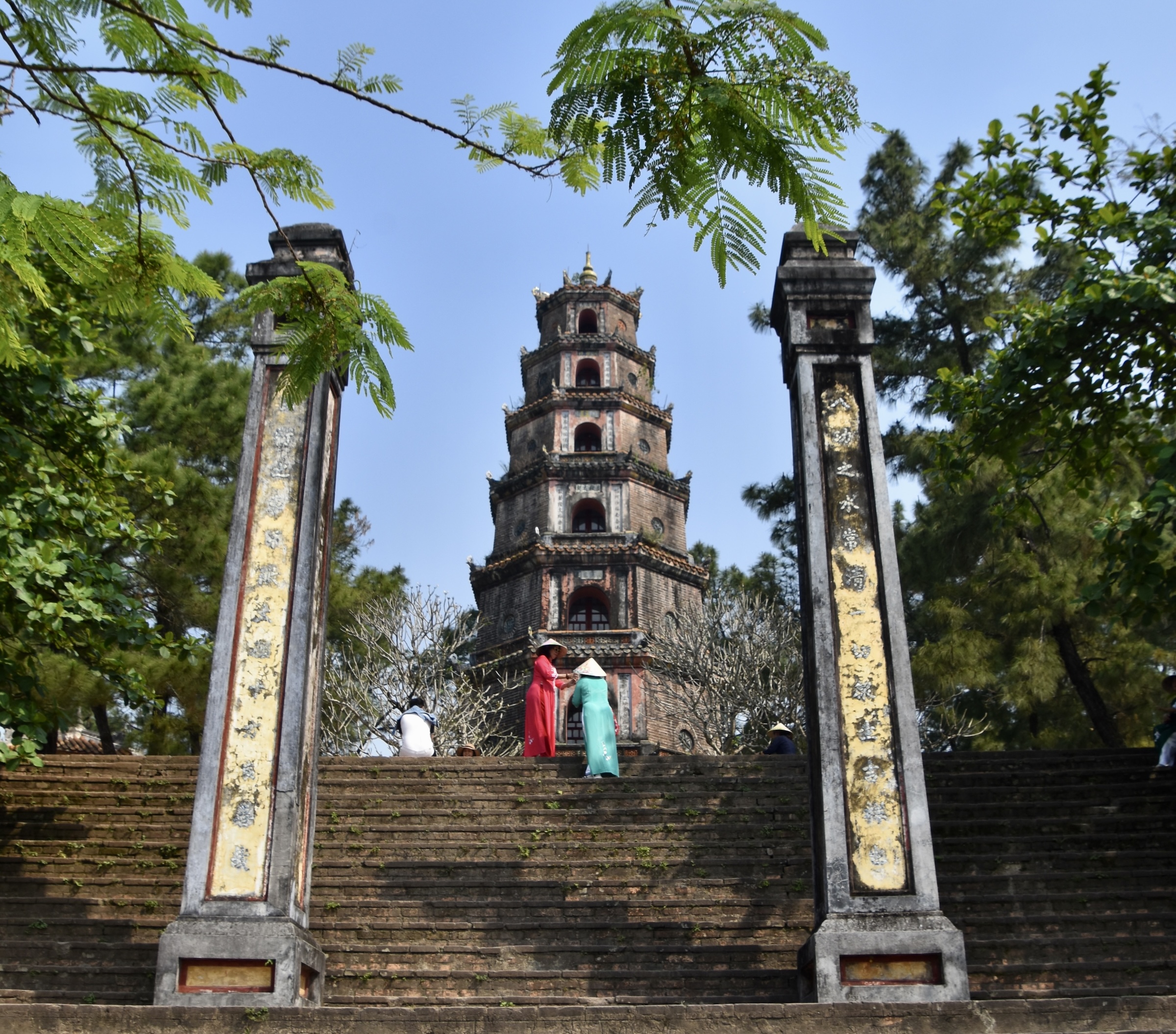
Most people approach from the land side through this gate.
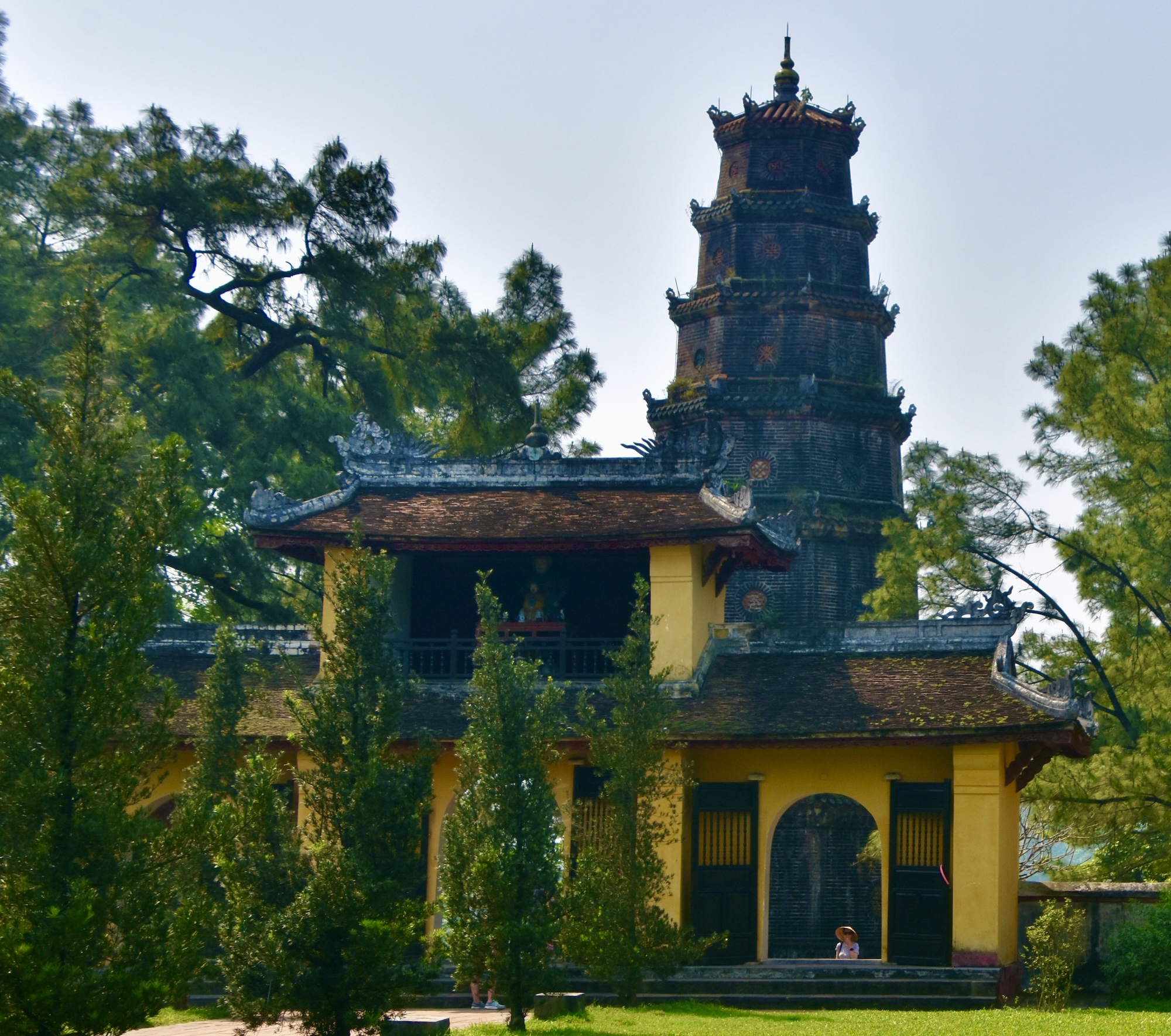
This is a Buddhist temple and inside the gate you will find some fearsome guardians such as this one.
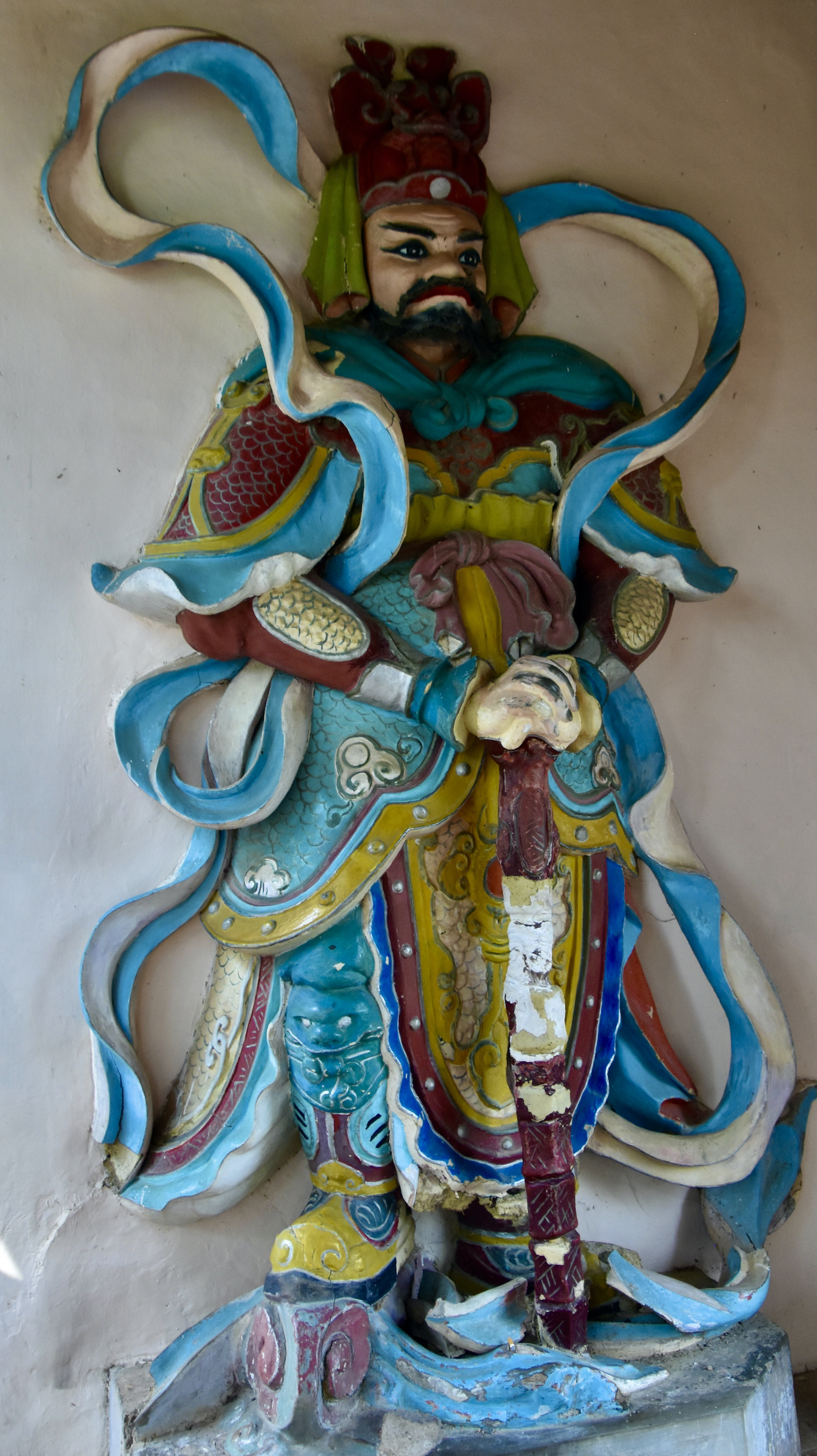
The temple prayer area is adorned with a statue of the Maitreya Buddha, a figure that could be compared to the Judeo-Christian Messiah, one who would come as the fifth and final Buddha of the world as we know it. It is a powerful icon in Vietnamese Buddhism that I’ll return to shortly.
The grounds of the Perfume Pagoda are very well maintained and worth exploring for its koi ponds and other small temples and monuments. This photo begs a closer look at the stupa in background.
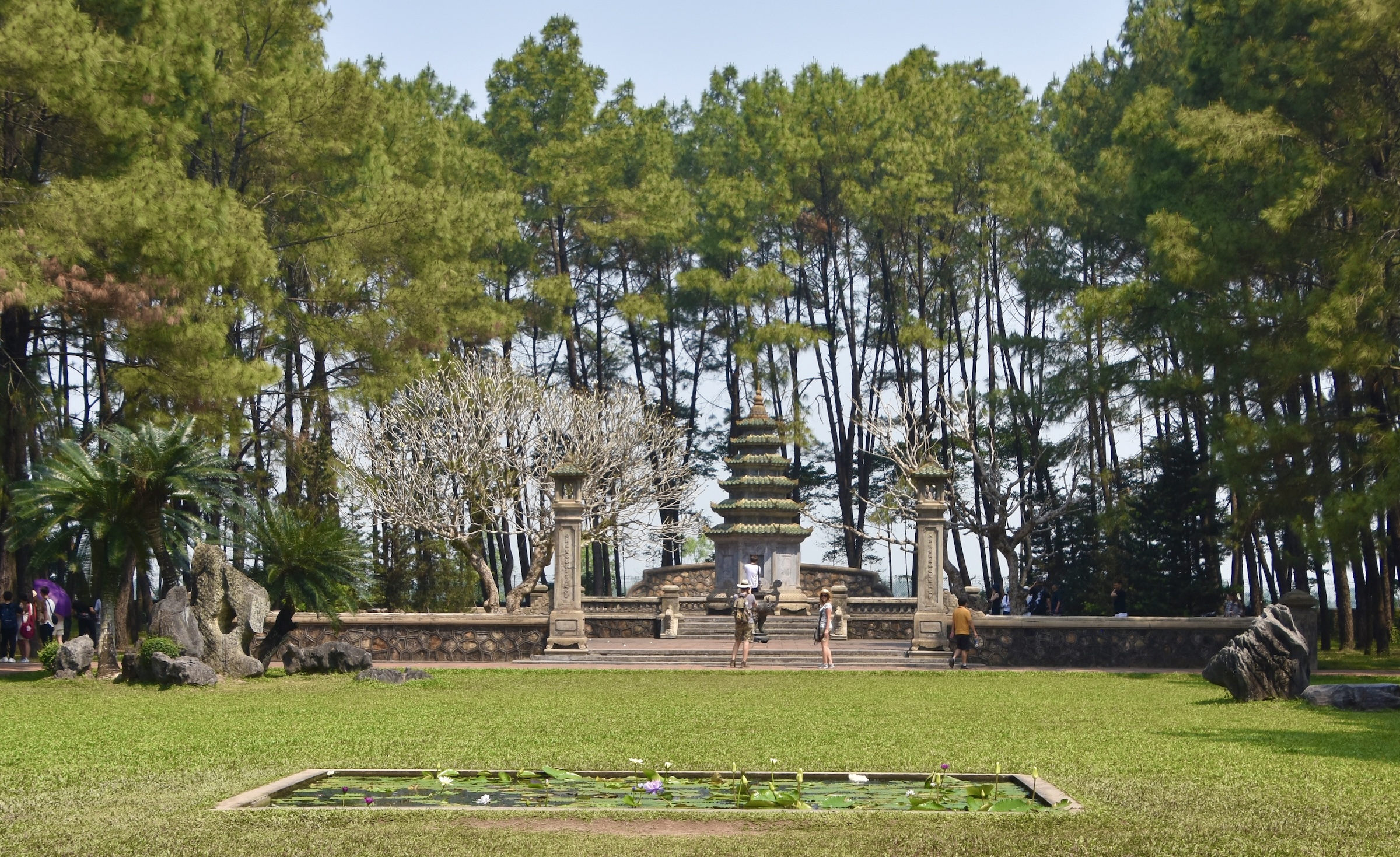
This stupa was erected to preserve the holy body and memory of Hoa Thuong Thich Don Hau, longtime head monk at the temple during much of the 20th century.
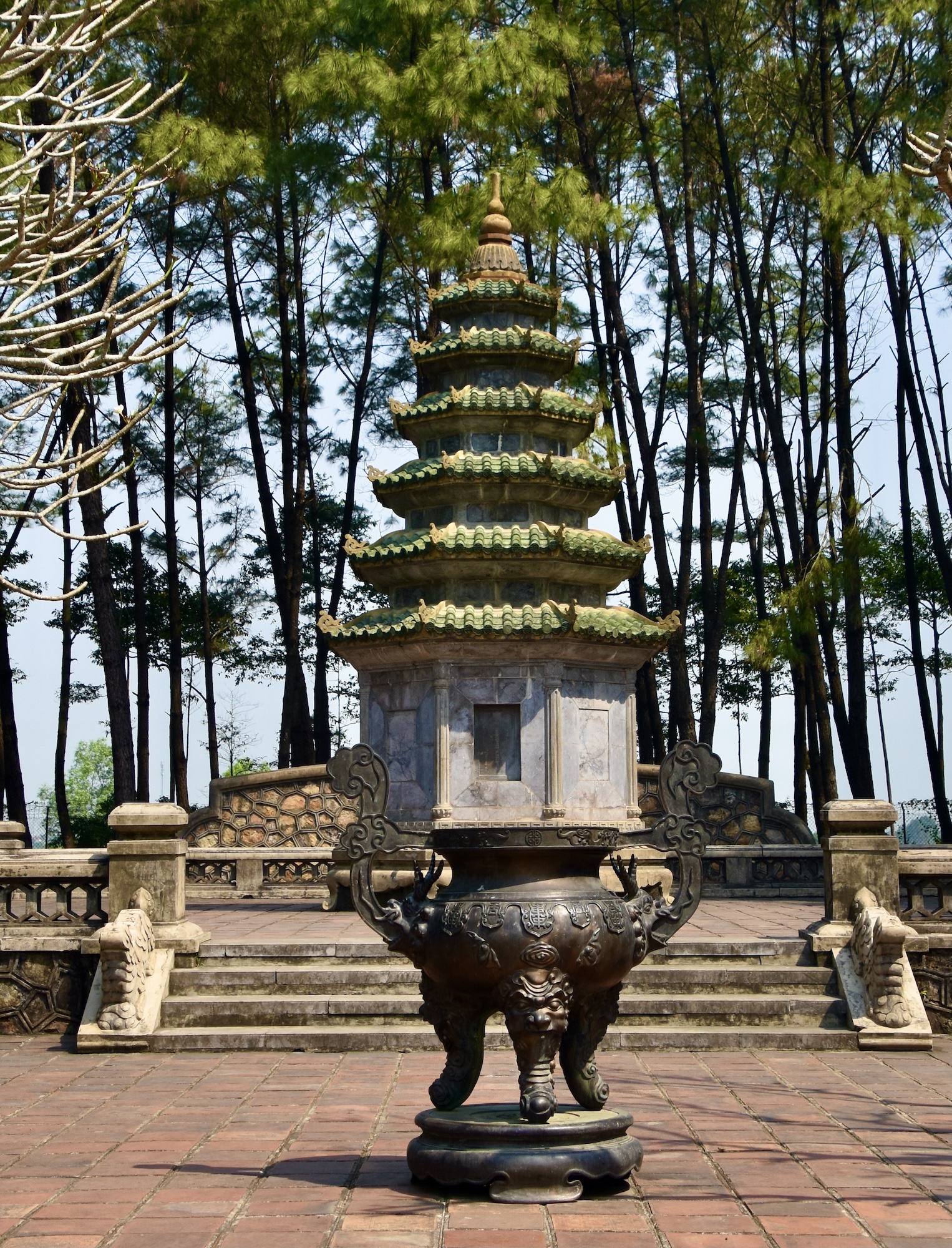
The temple became a centre of controversy in the early 1960’s when Buddhists protested the Catholic President of South Vietnam Ngo Dinh Diem’s treatment of them in favour of his Catholic supporters. In 1963 nine Buddhists were gunned down in Hue on the birthday of the Buddha which set off massive protests across South Vietnam. These culminated with the self-immolation of Buddhist monk Thich Quang Duc in Saigon which was captured on film and caused a worldwide reaction against the Diem regime and eventually forced it to back off the repression. As young as I was, I still remember the photo of the monk calmly sitting in an intersection without flinching as his life literally went up in flames.
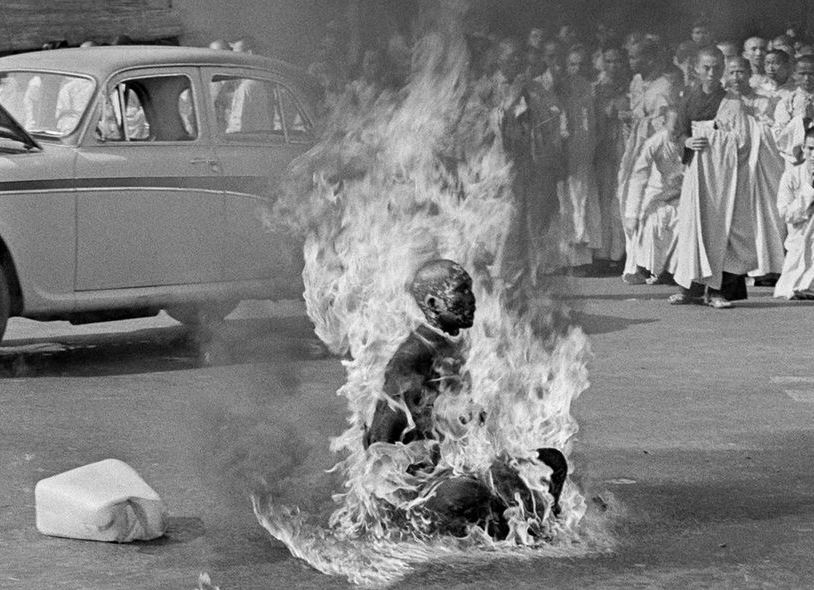
As a reminder of that event you can see the very motor car that drove the monk to his place of death on display at the Perfume Pagoda.
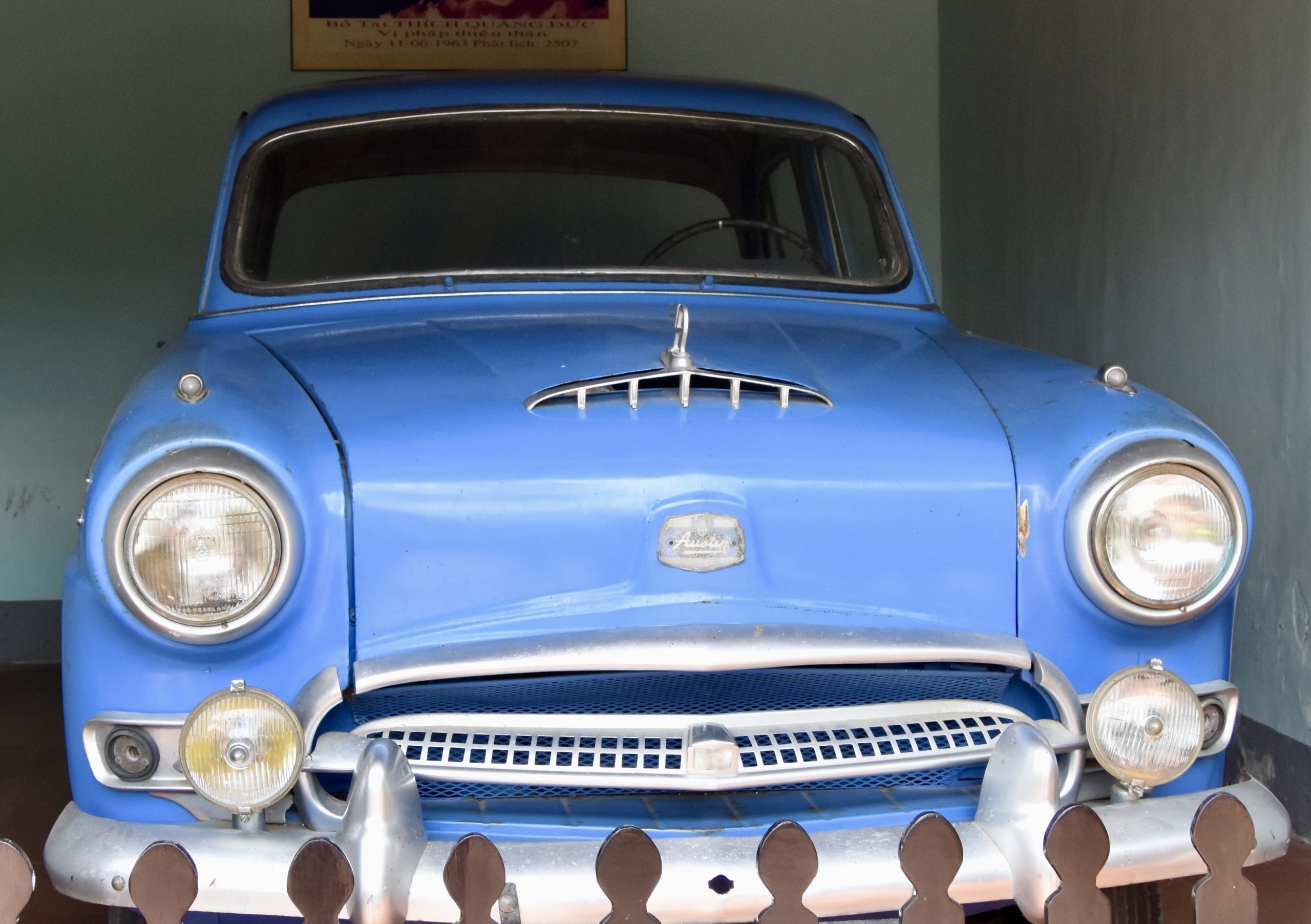
On that less than salutary note let’s head to another place of death before going to the Citadel.
Tu Duc Mausoleum
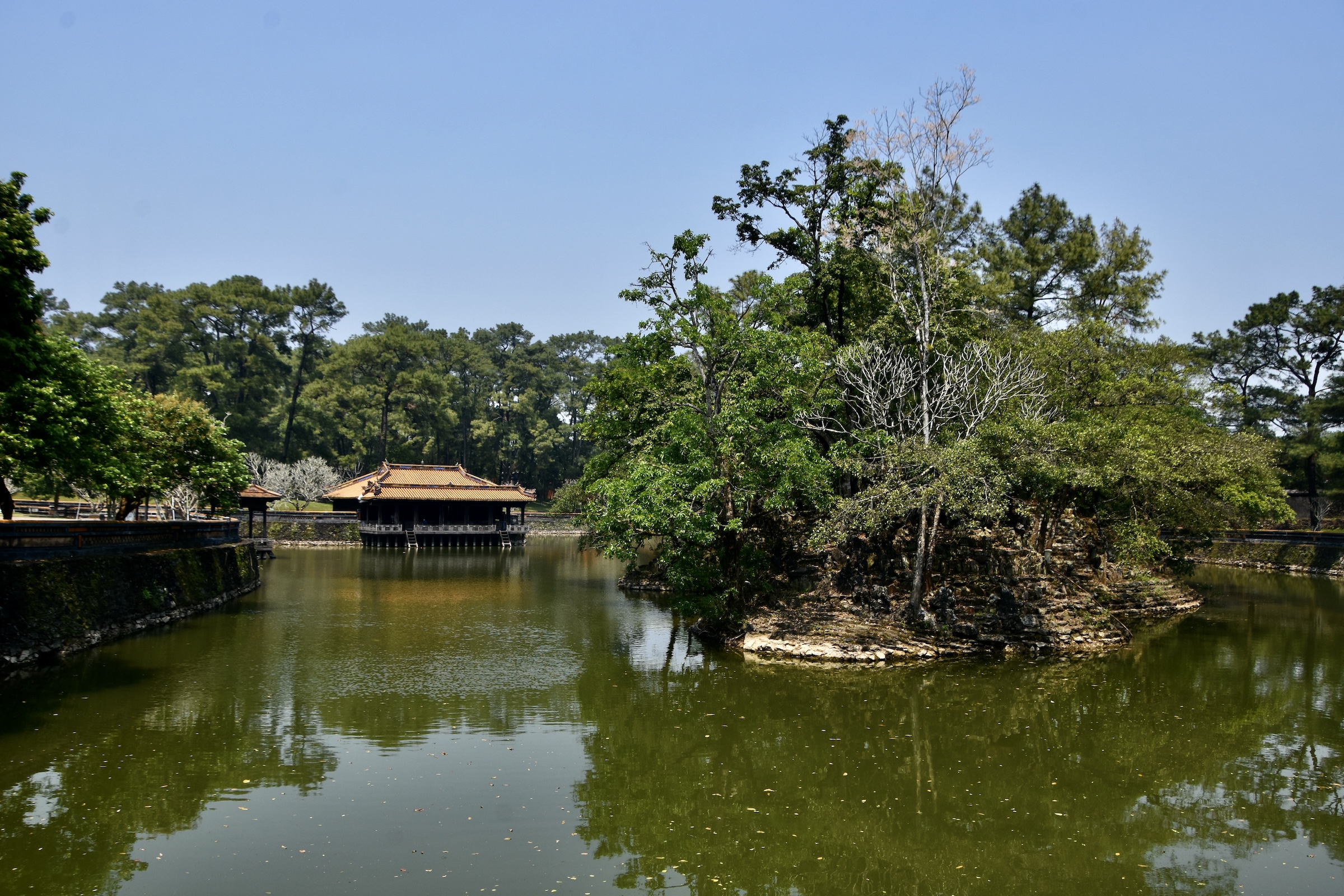
Tu Duc was the longest serving Nguyen emperor of Vietnam reigning from 1848 to 1883, a period that was racked with plague, famine, rebellion and eventual loss of control of Vietnam to the French, who had helped him maintain the throne throughout these many debacles. He had 104 wives and concubines yet never fathered a son which left him a lot of time to think about his legacy. From 1864-1867 he set about building an artificial island and creating a magnificent pastoral setting for his eventual mausoleum which he would not occupy for another sixteen years.
Located on the outskirts of Hue the mausoleum grounds are a great place to stroll around and admire Tu Doc’s many improvements starting with the artificial island seen above which once was the home of a number of exotic animals which the emperor liked to hunt. He also spent a lot of time boating on the canals he had built.
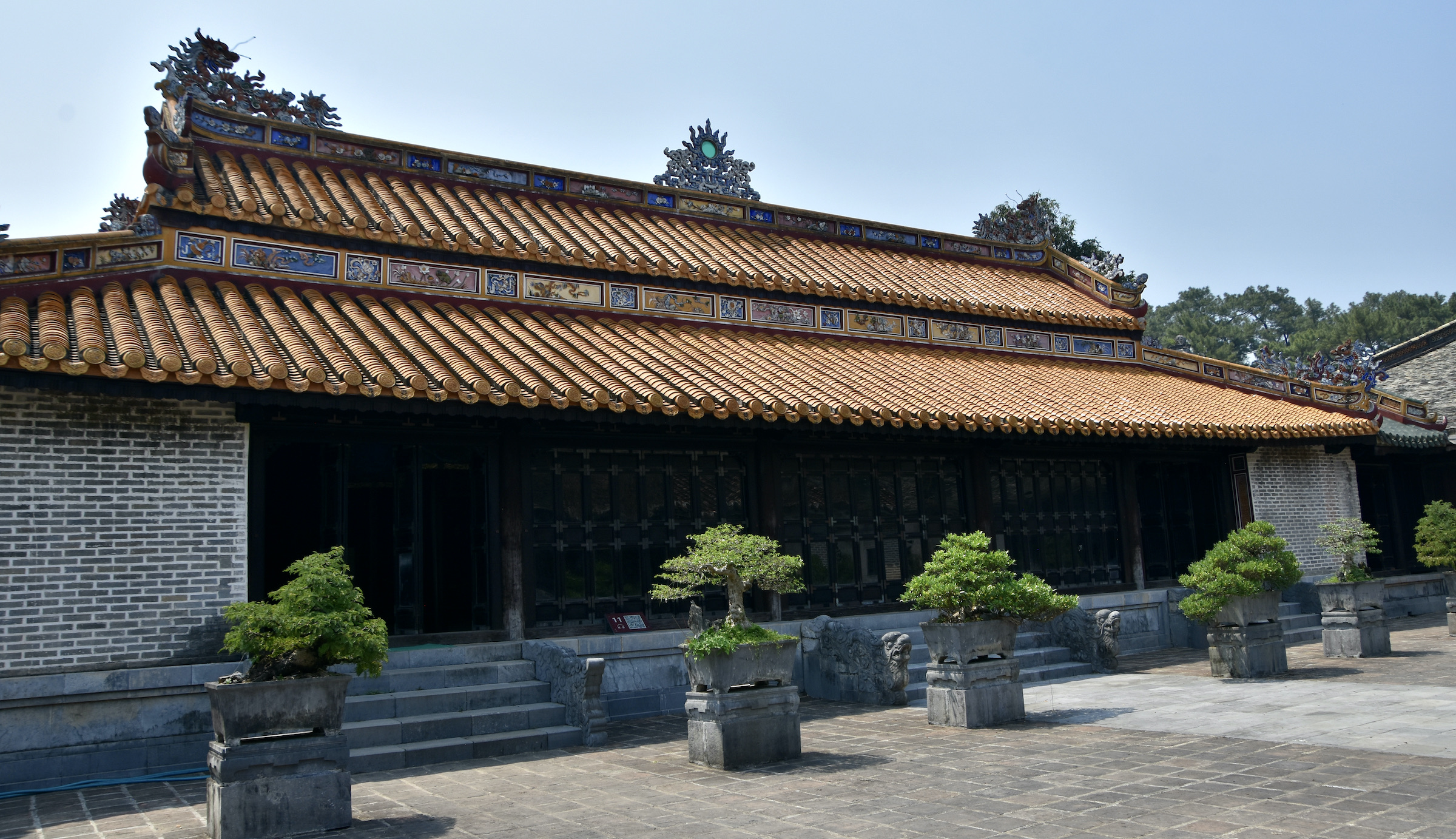
Tu Duc was nothing if not a dedicated husband to his many wives and built this temple dedicated to them. Inside you will find this golden throne where his wives could pay obeisance to him.
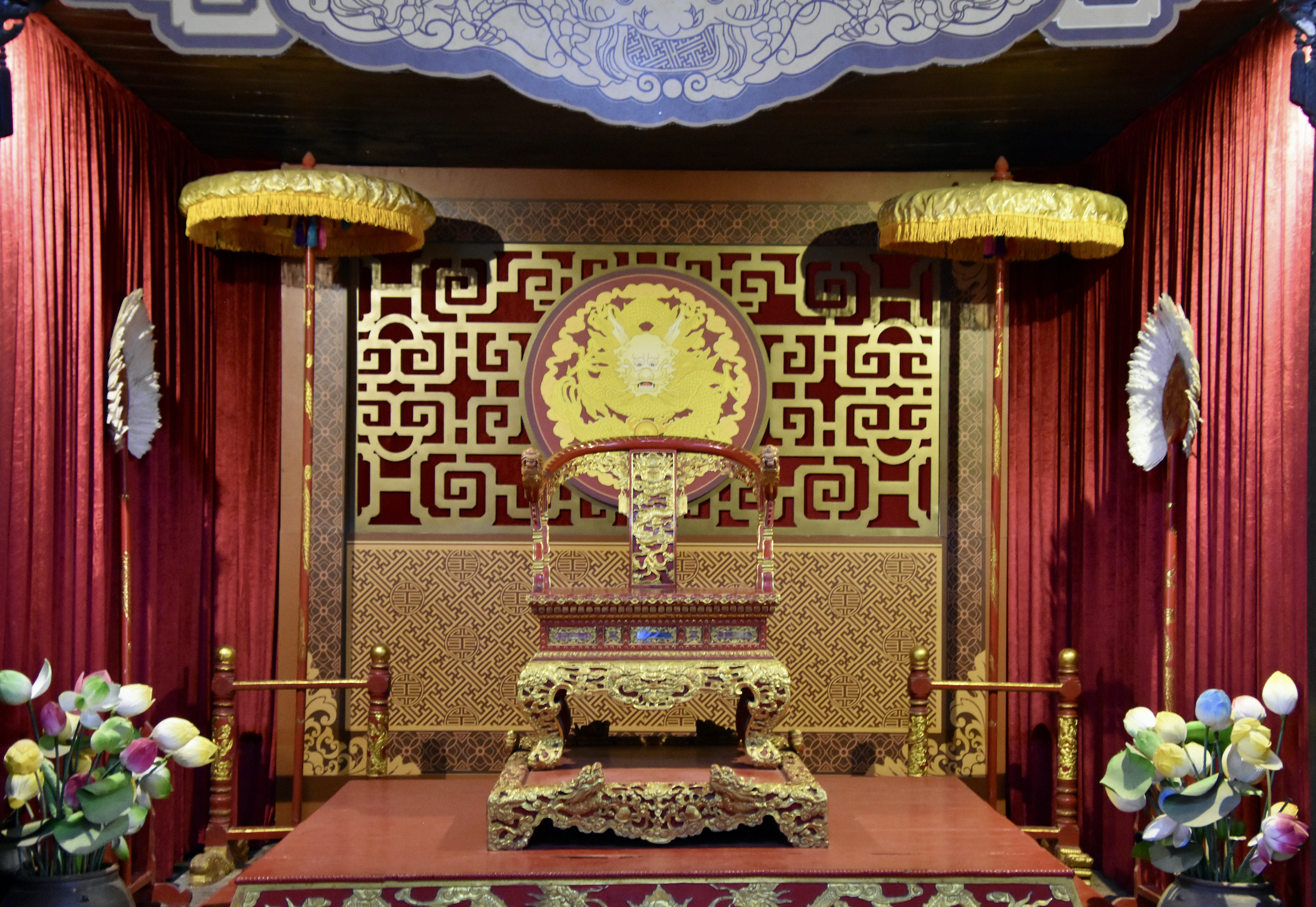
There is also the royal palanquin on which he would be borne rather than get his feet soiled by actually touching the ground.
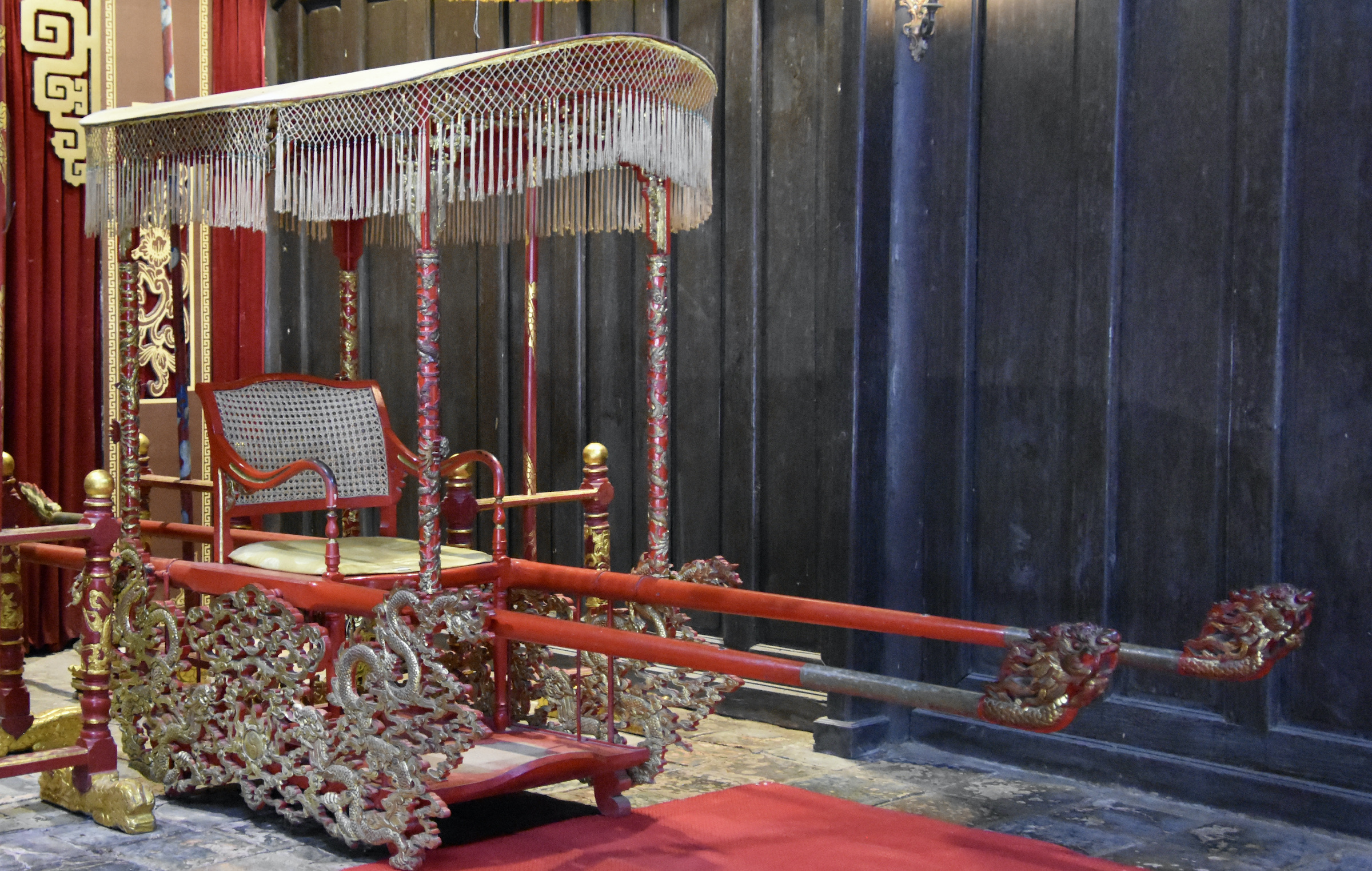
For a separate fee you can be dressed in royal clothing and be seated on the throne and palanquin, but absolutely no sitting without royal clothing.
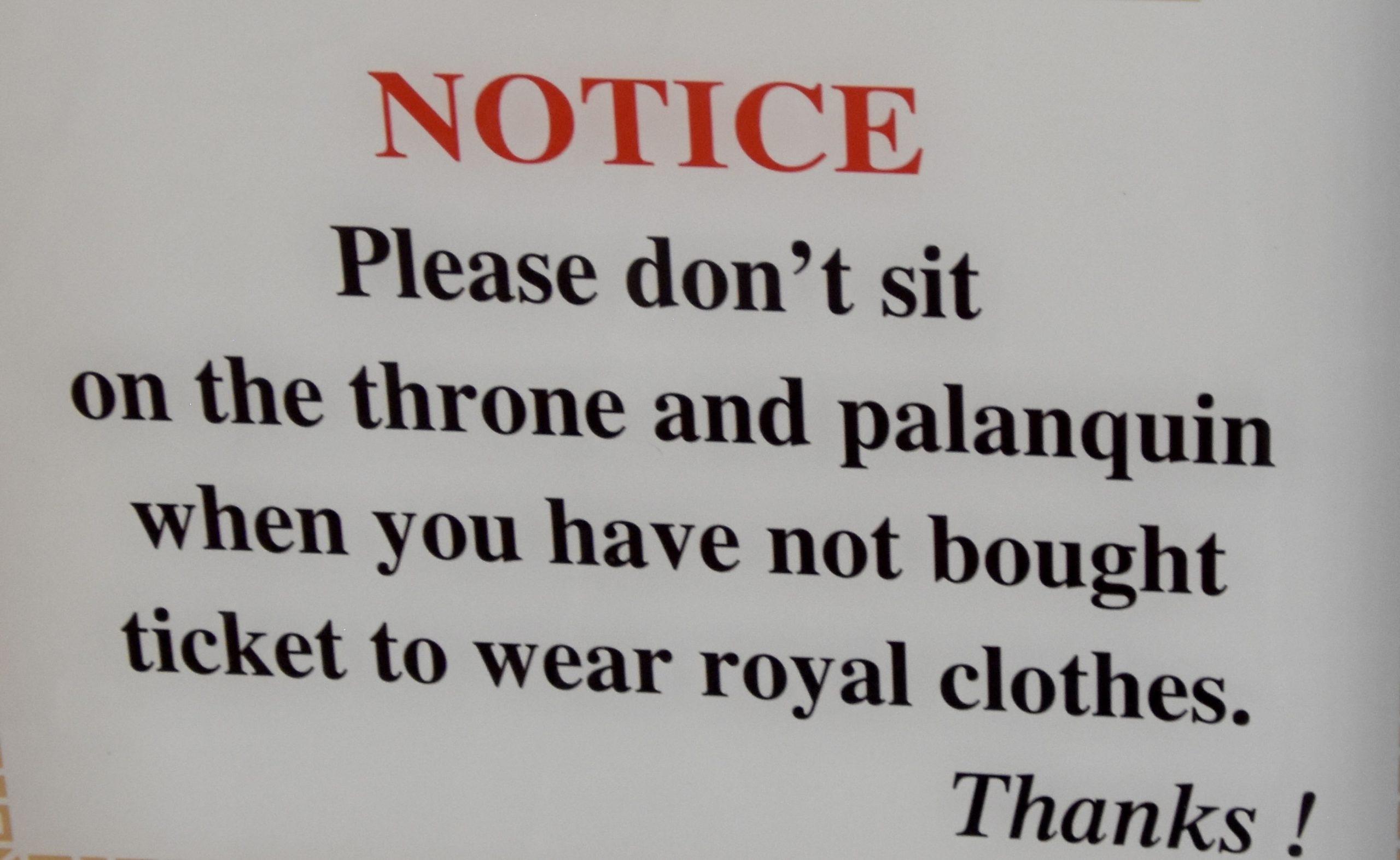
Despite his polygamy, Tu Duc did have a favourite wife, Khiem Tho for whom he built this wonderful entrance to her tomb. She actually survived him by 19 years and was not raid to rest inside until 1902.
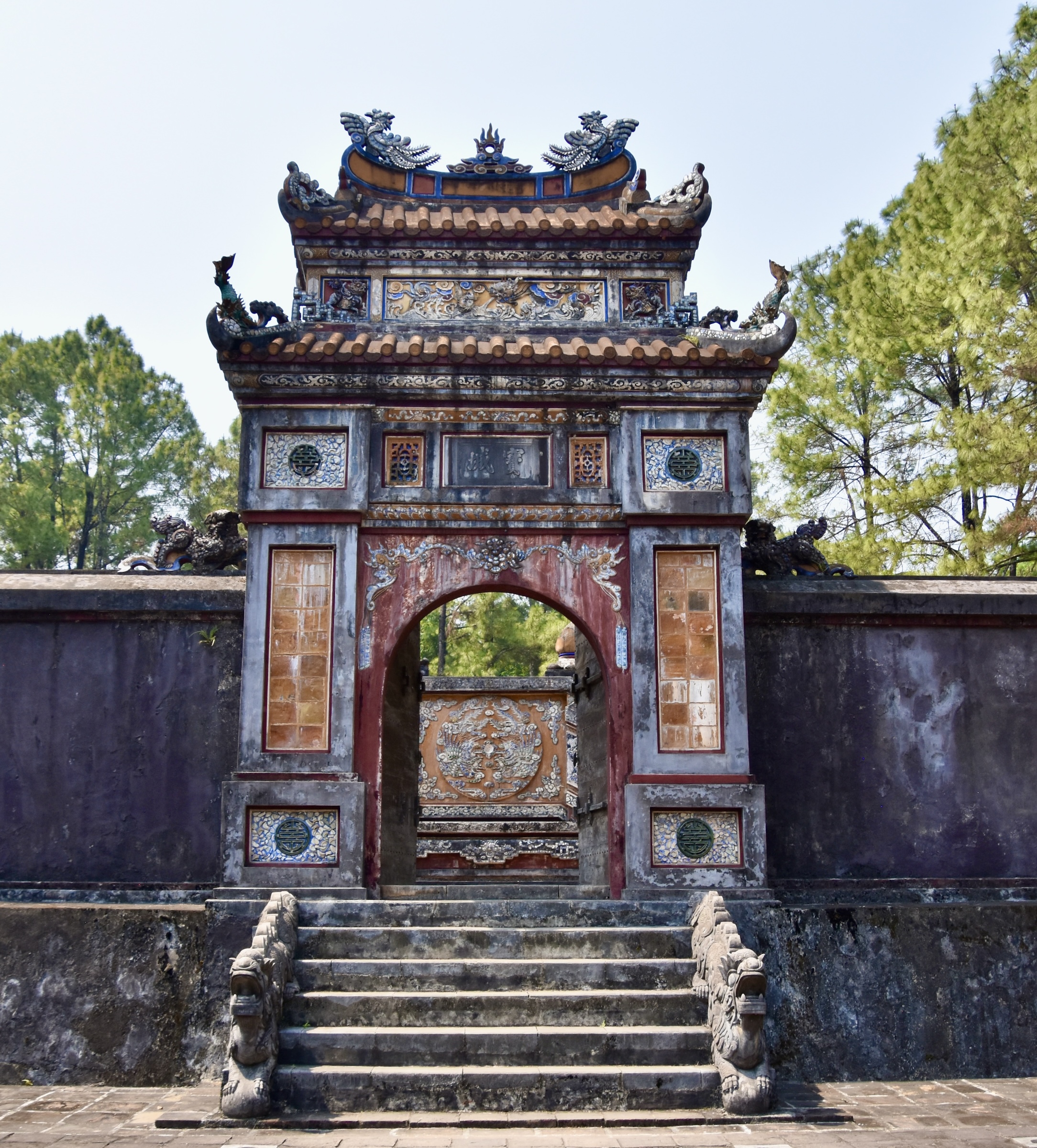
This structure stands at the highest point on the mausoleum grounds and was built to house a simple stele.
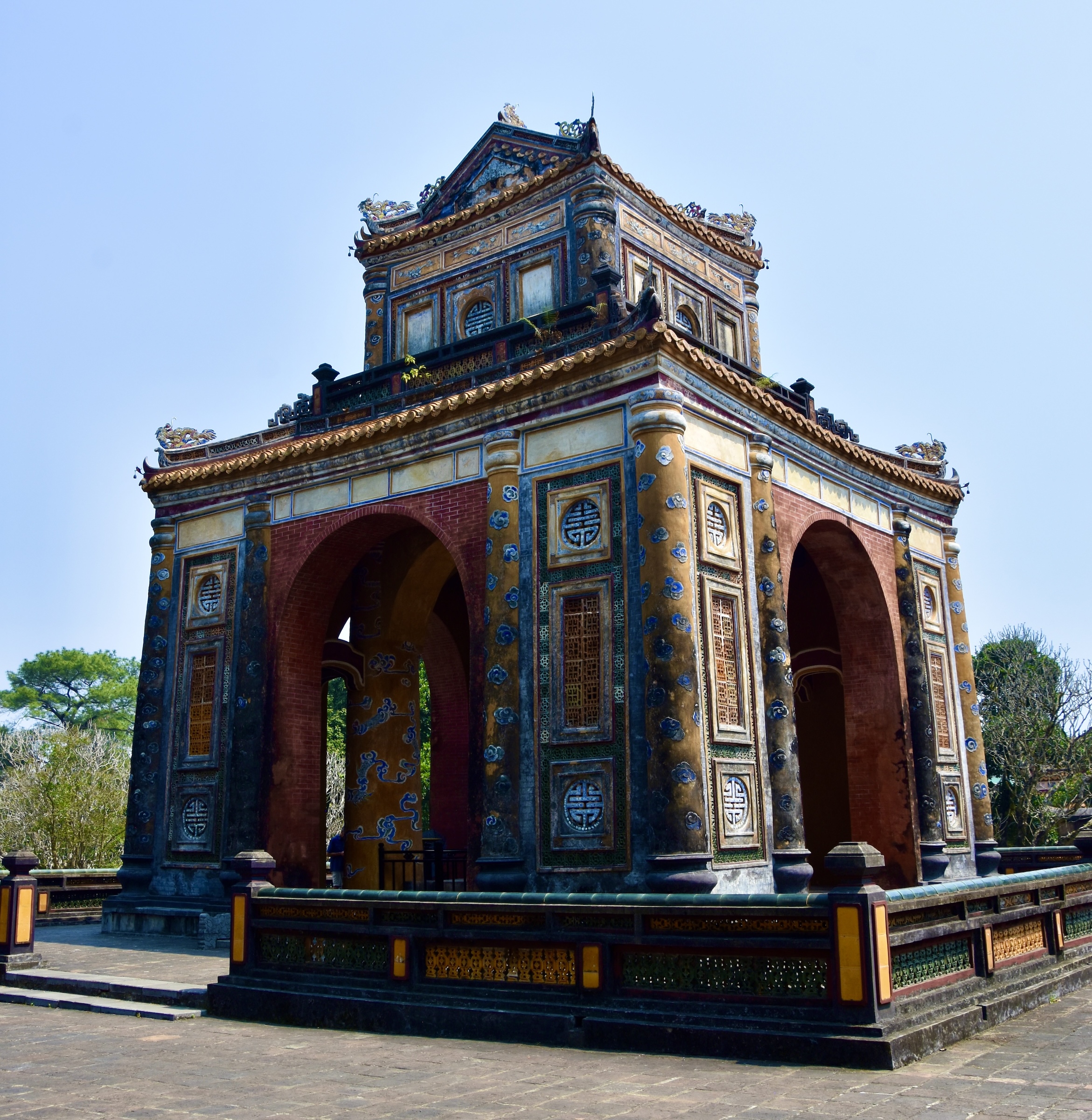
And this is the stele which tells of all the magnificent deeds of Tu Duc’s long if not overly glorious reign. It is the longest known epitaph in Vietnam.
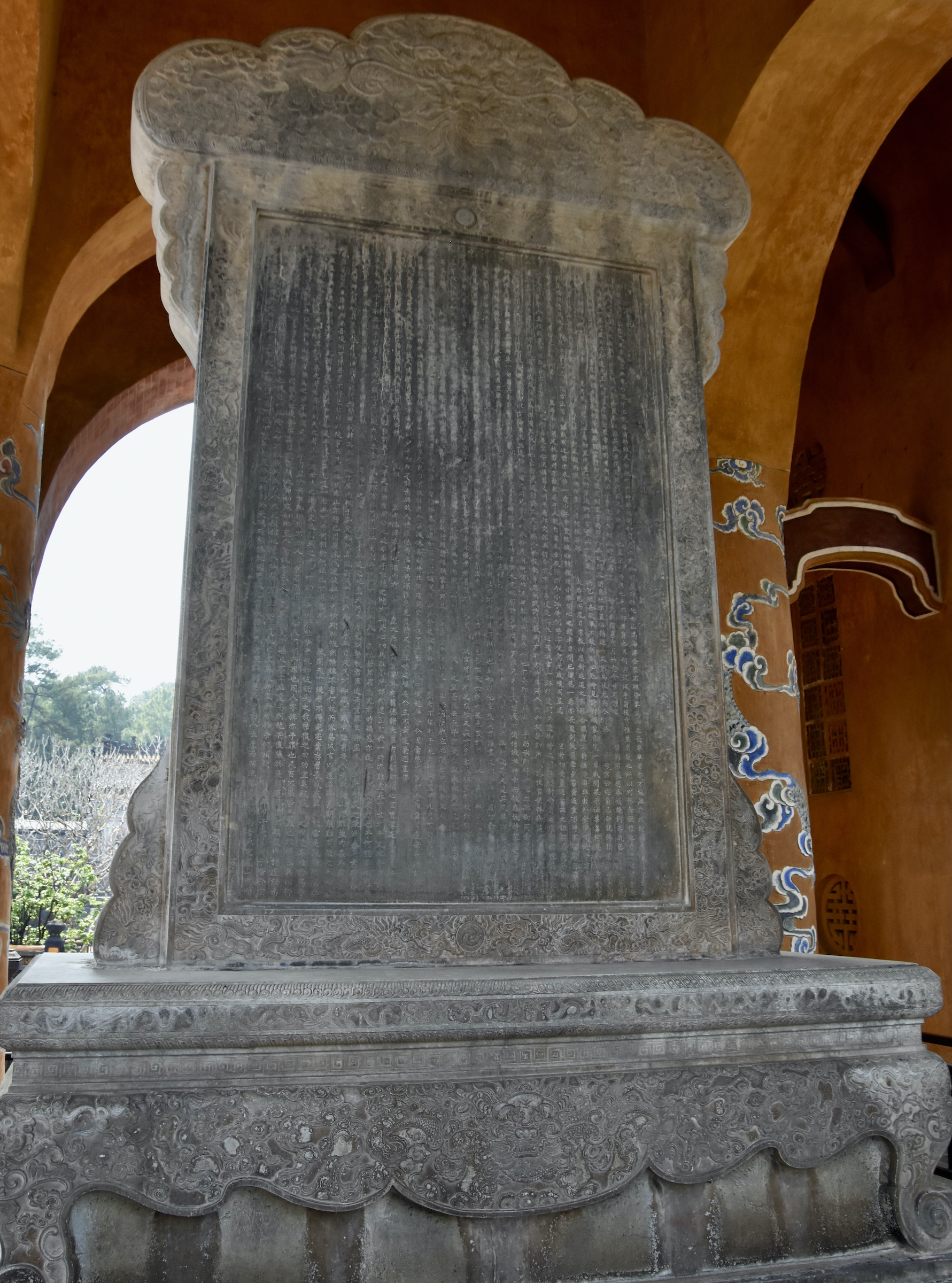
Below this structure are four guardians who unfortunately for Tu Duc failed to do their job in keeping westerners from coming to dominate Vietnam during his reign.
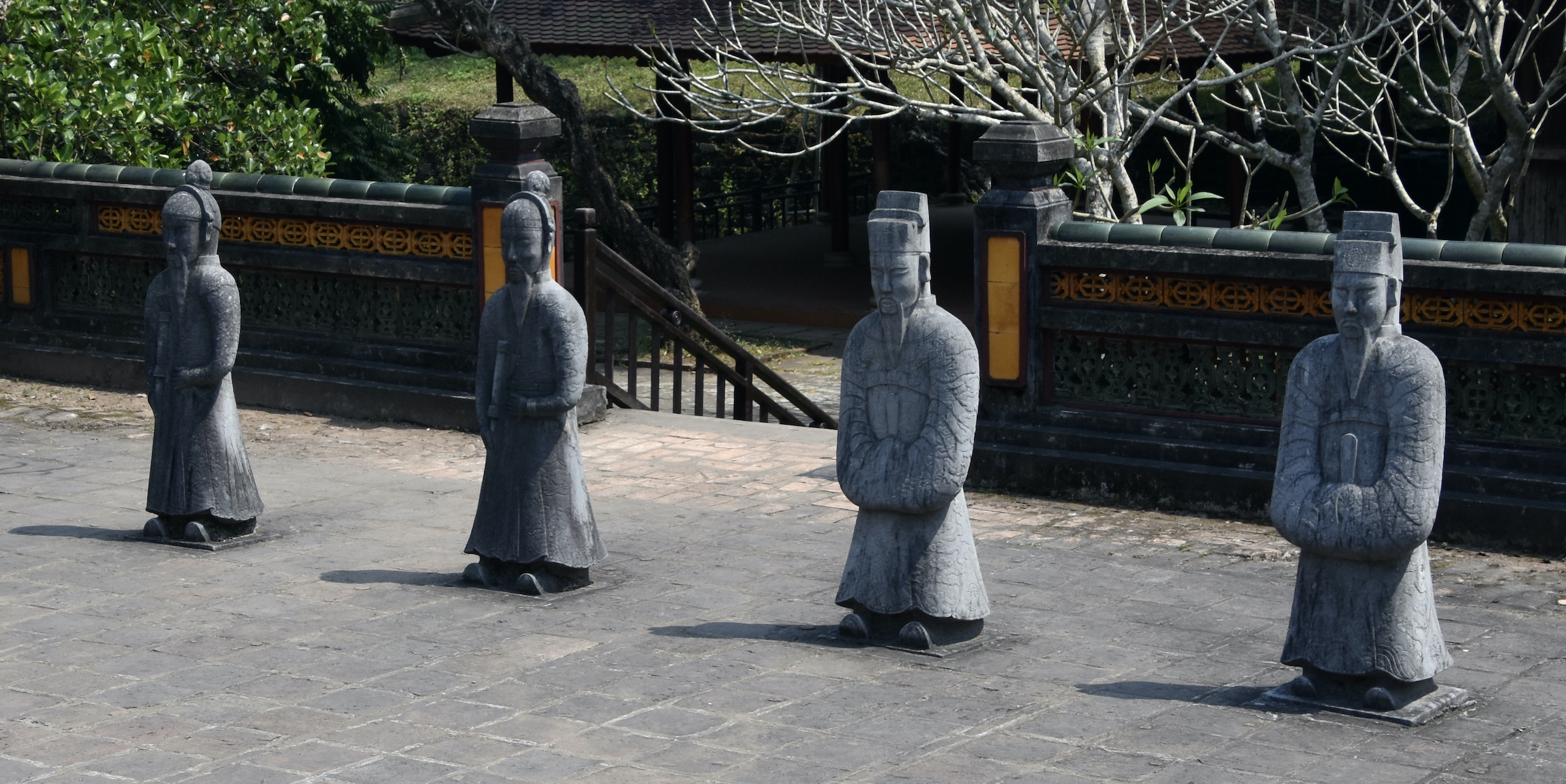
Somewhat more useful if earthbound are the elephant and horse that stand beside the guardians.
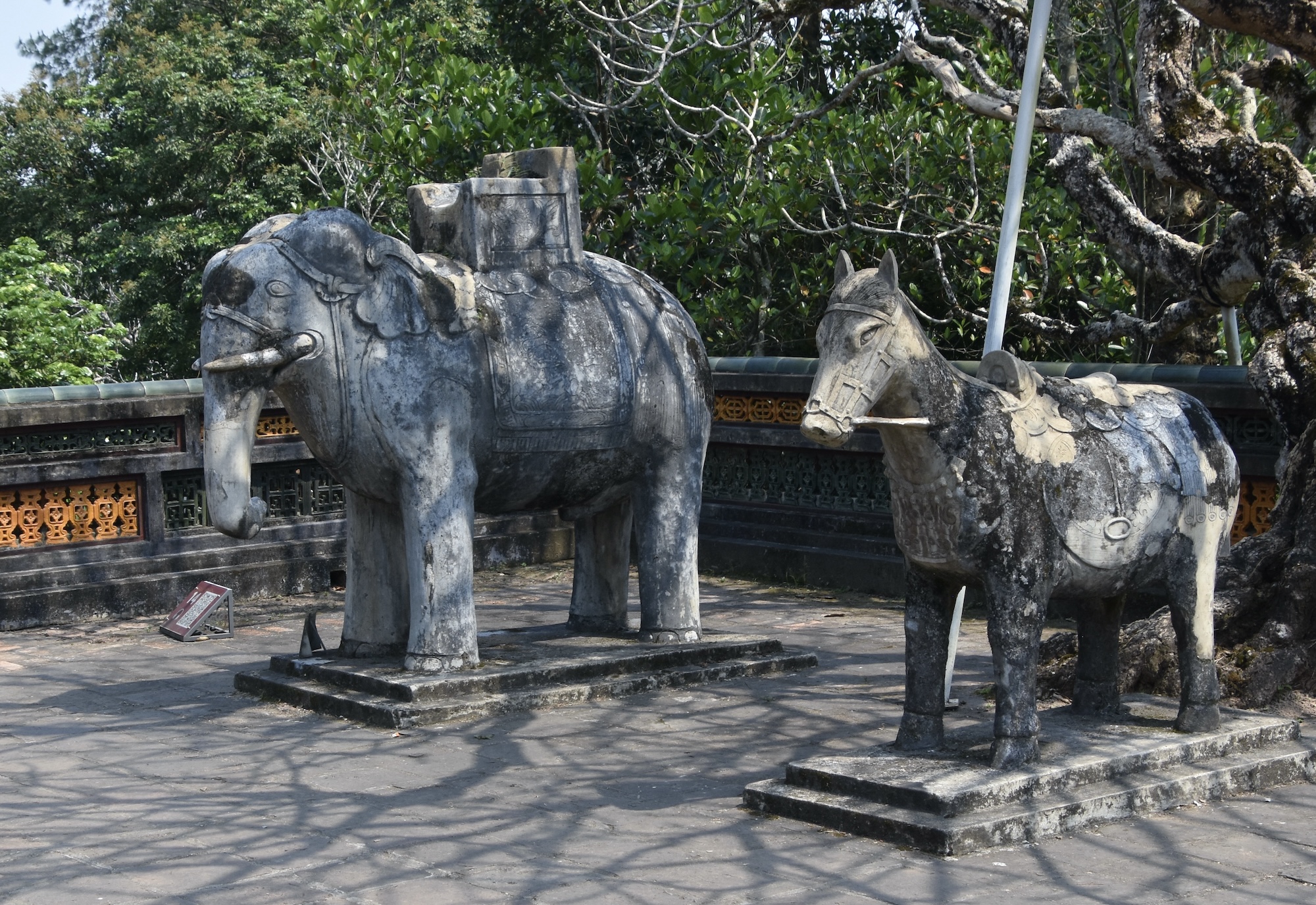
And at last we come to Tu Duc’s tomb which we will find after passing though this archway.
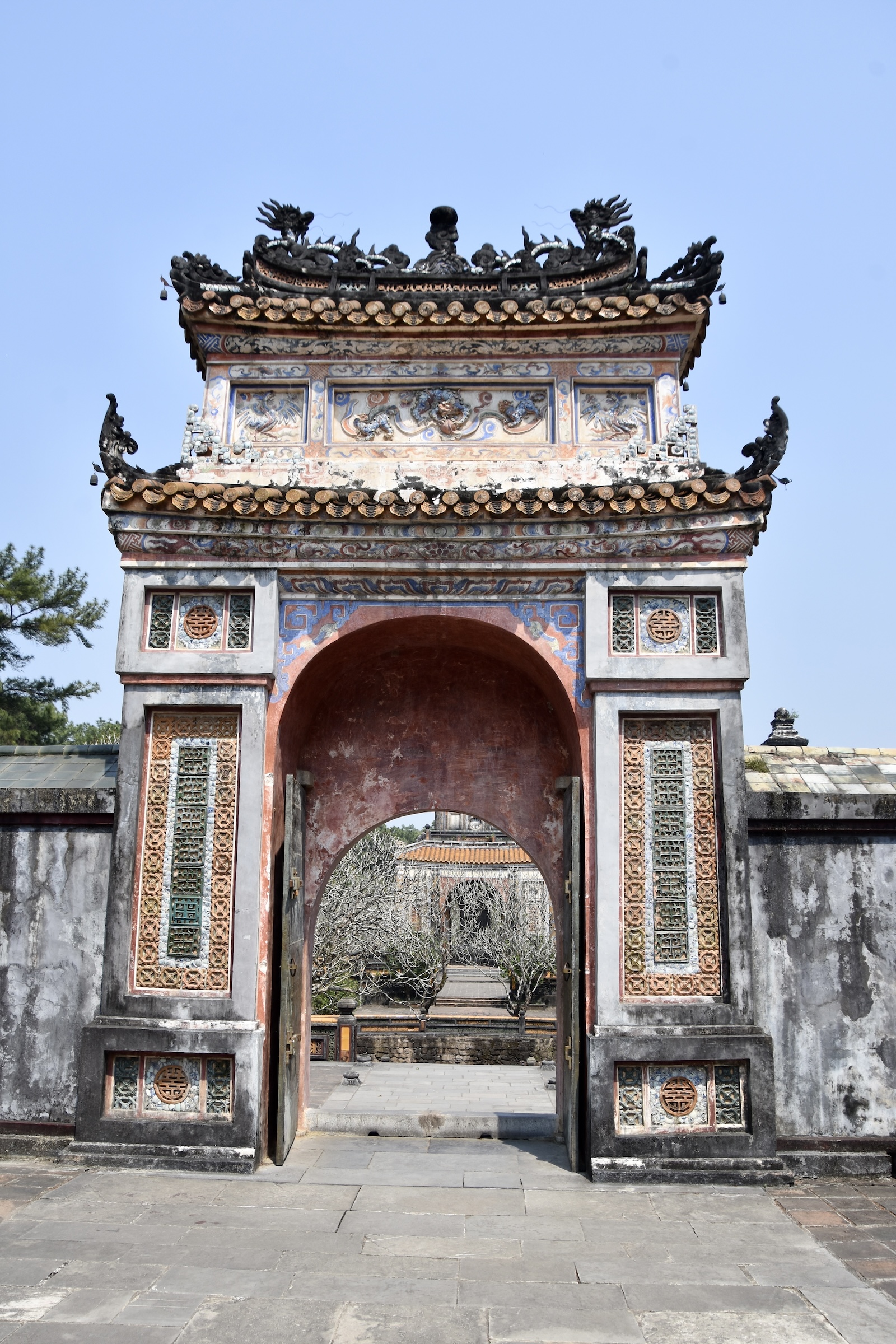
Here is the actual tomb. Except it isn’t. After his death in 1883 his body was secreted to a burial site that is unknown to this day. The 200 soldiers who moved and buried him were all beheaded in thanks for their service and so the final joke was on Tu Duc who didn’t get to rest in magnificence, but rather to rot in anonymity. Seems fitting somehow.
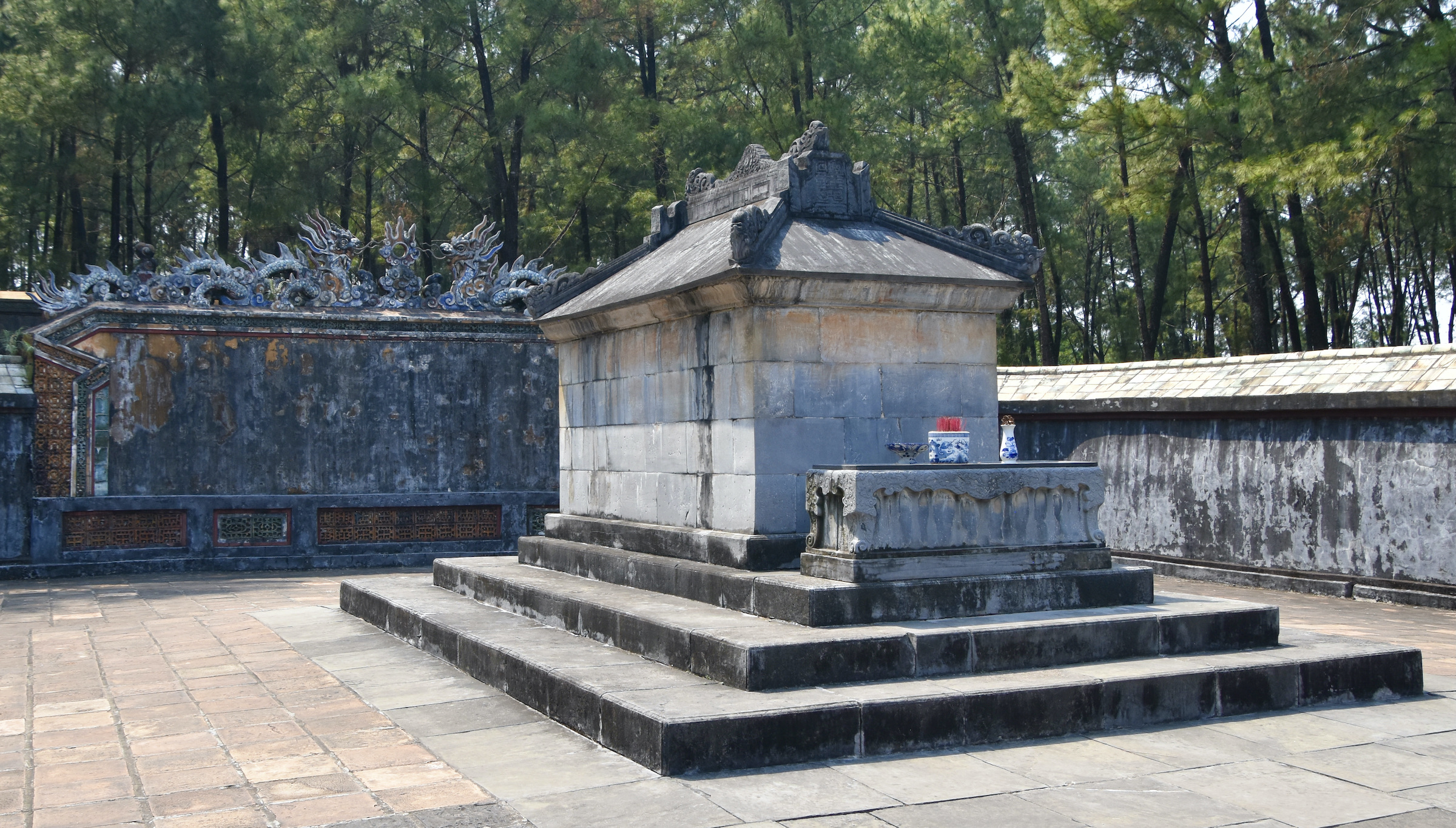
The Citadel of Hue
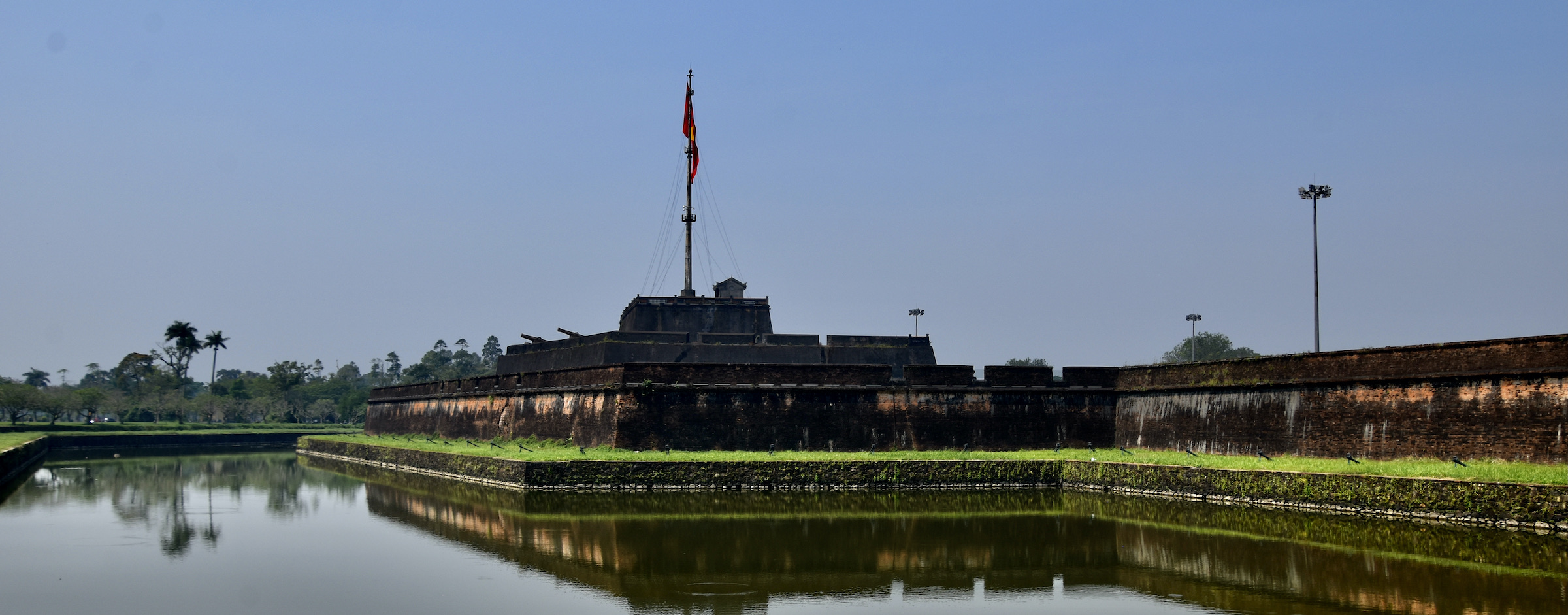
Our last destination in Hue is the UNESCO World Heritage Site of the Citadel of Hue which is enclosed by a moat that stretches for over 10 kms. (6.2 miles). Inside once were housed the administrative and military headquarters and the royal residences all in one location that presided over Vietnam from 1802 to 1945.
The Citadel was deliberately designed to imitate the Forbidden City in Beijing as the first Nguyen emperor Gia Long was a great admirer of Chinese statecraft. This simple map shows the three different levels of the Hue Citadel – the entire Citadel area, the smaller Imperial City and the even smaller Forbidden City. Our tour will be confined to the latter two areas.
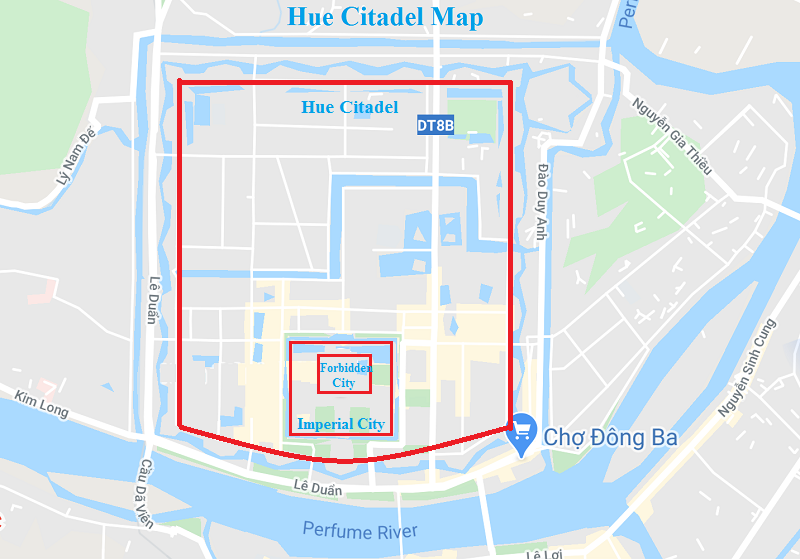
This is a map of the Imperial City showing existing buildings in red and ruined buildings in green. As you can see virtually nothing is left of the actual Forbidden City which was first attacked during the French Indochina War in 1947 and finished off in the Vietnam War. Only 20 of the original 148 buildings remain. The more we see of Vietnam and Laos, the more pissed off I get at the wanton destruction of those countries by those useless colonial and post-colonial wars (and we haven’t even got to Cambodia yet). The Americans and French really need to step up and fund the rebuilding of this World Heritage Site, but I’m not holding my breath.
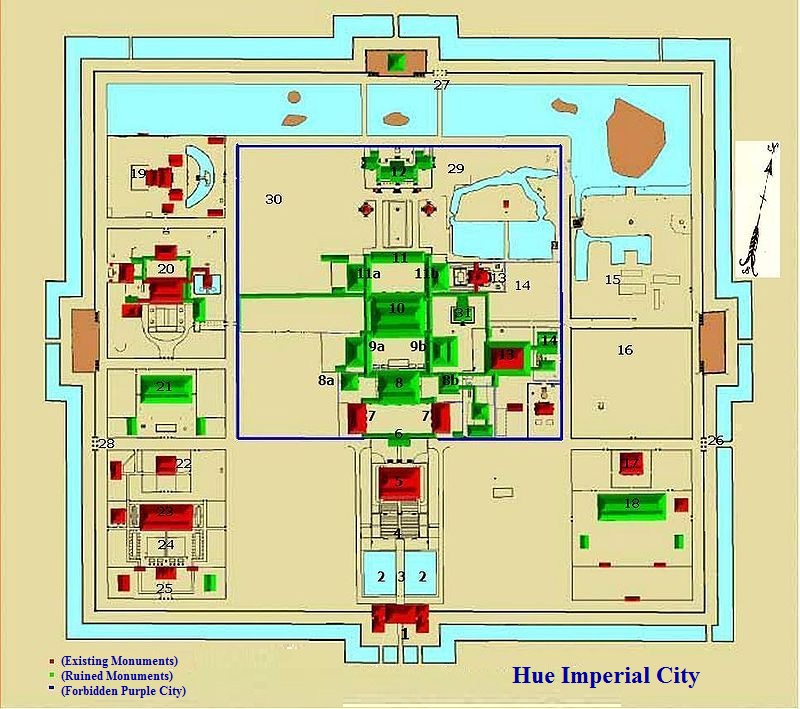
Anyway let’s make do with what still stands starting with the South Gate which is imposing to say the least.
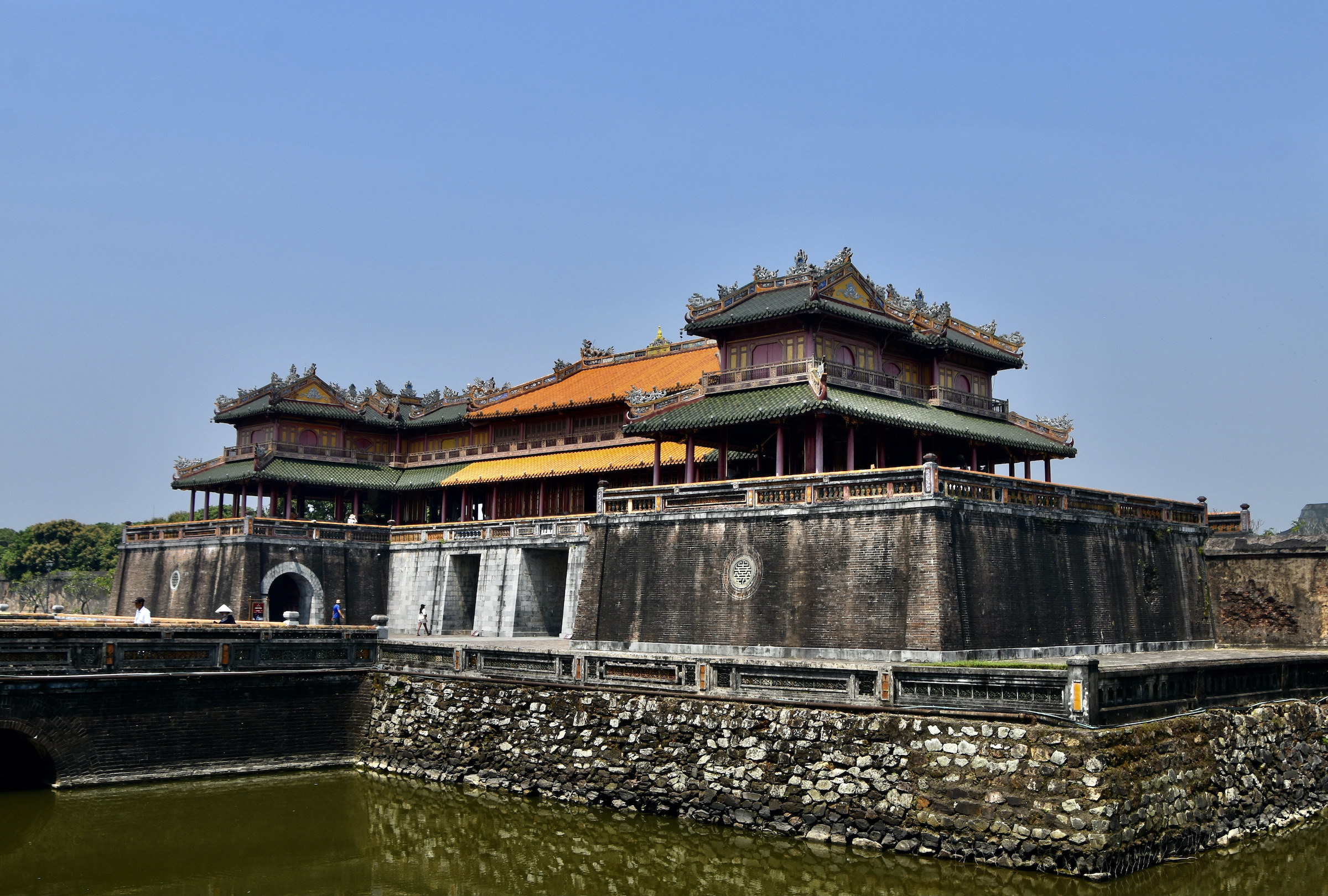
Turning left after crossing over the moat and through the gate we come to an area with the greatest number of original buildings. There are a few of the inner gates still standing.
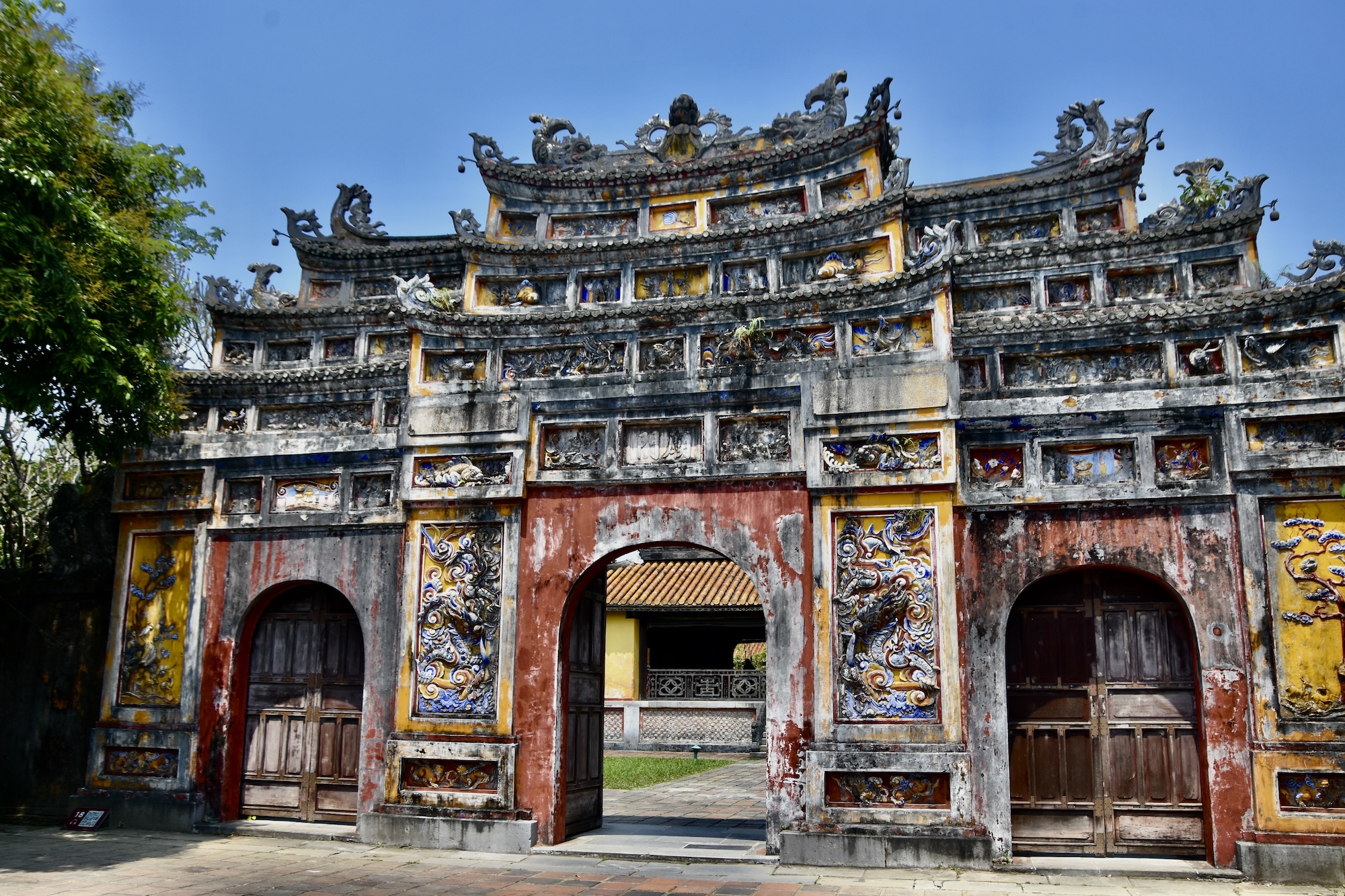
Our group listens in the shade on the other side as our local guide explains the significance of the buildings in this area.
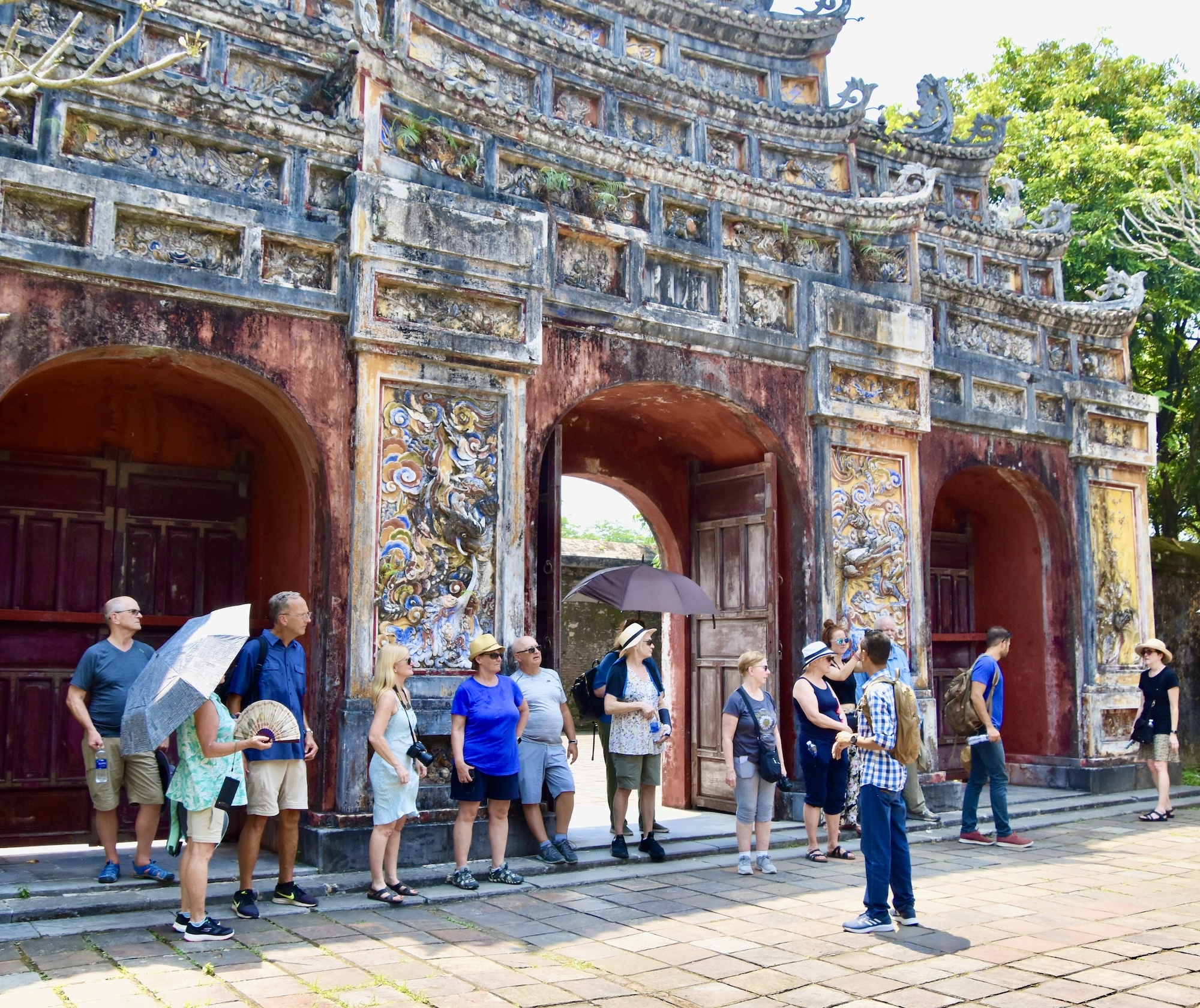
This is the Hien Lam pavilion which was built in 1821-22. You pass through this to get to one of the few remaining temples in the Hue Citadel.
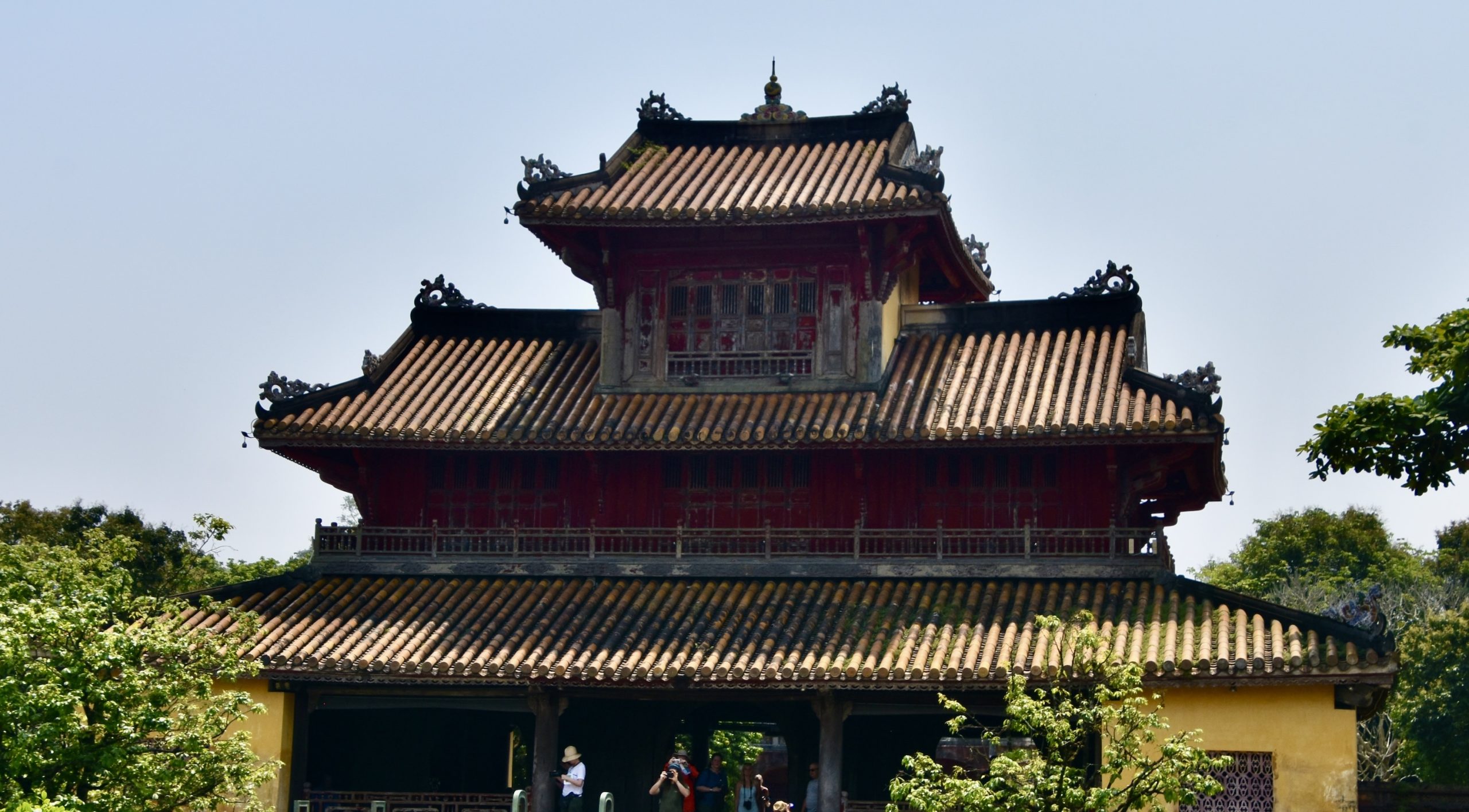
Between the pavilion and the Mieu Temple are the nine Dynastic Urns of Hue, all cast in bronze and each with very detailed scenes representing the reign of different emperors. They are very impressive.
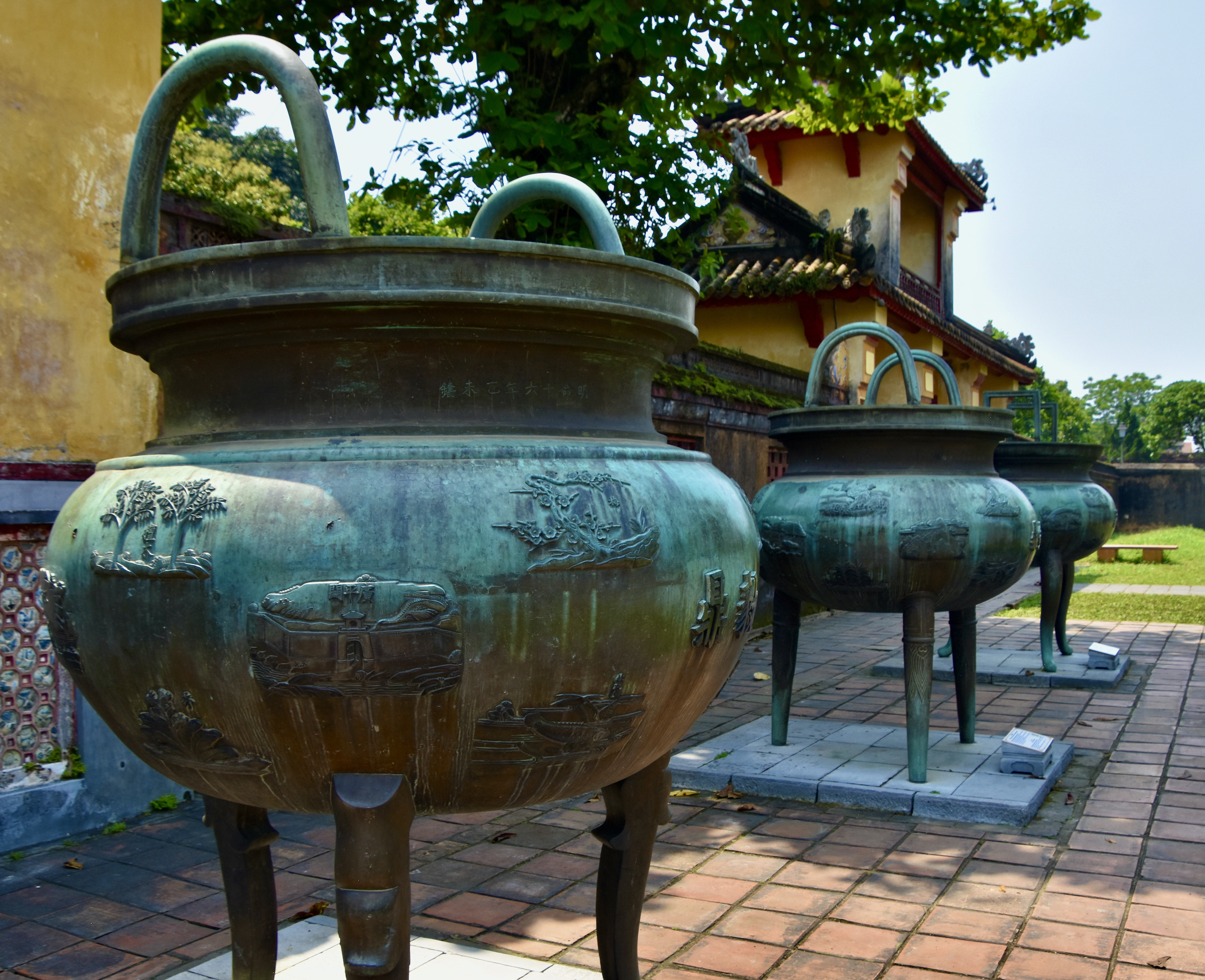
This is the Mieu Temple which has been completed restored since the Vietnam War. It was built as a site to worship the Nguyen emperors.
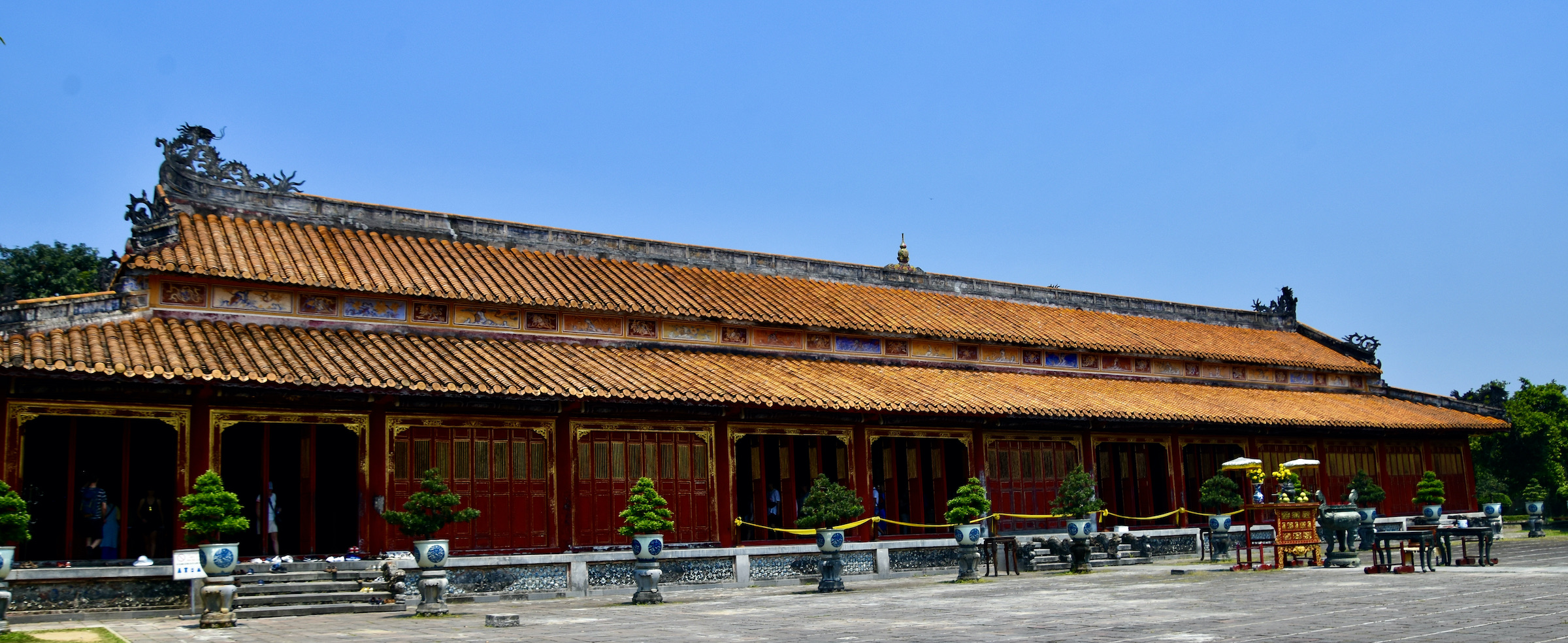
Inside there are spaces dedicated to each of the Nguyen emperors.
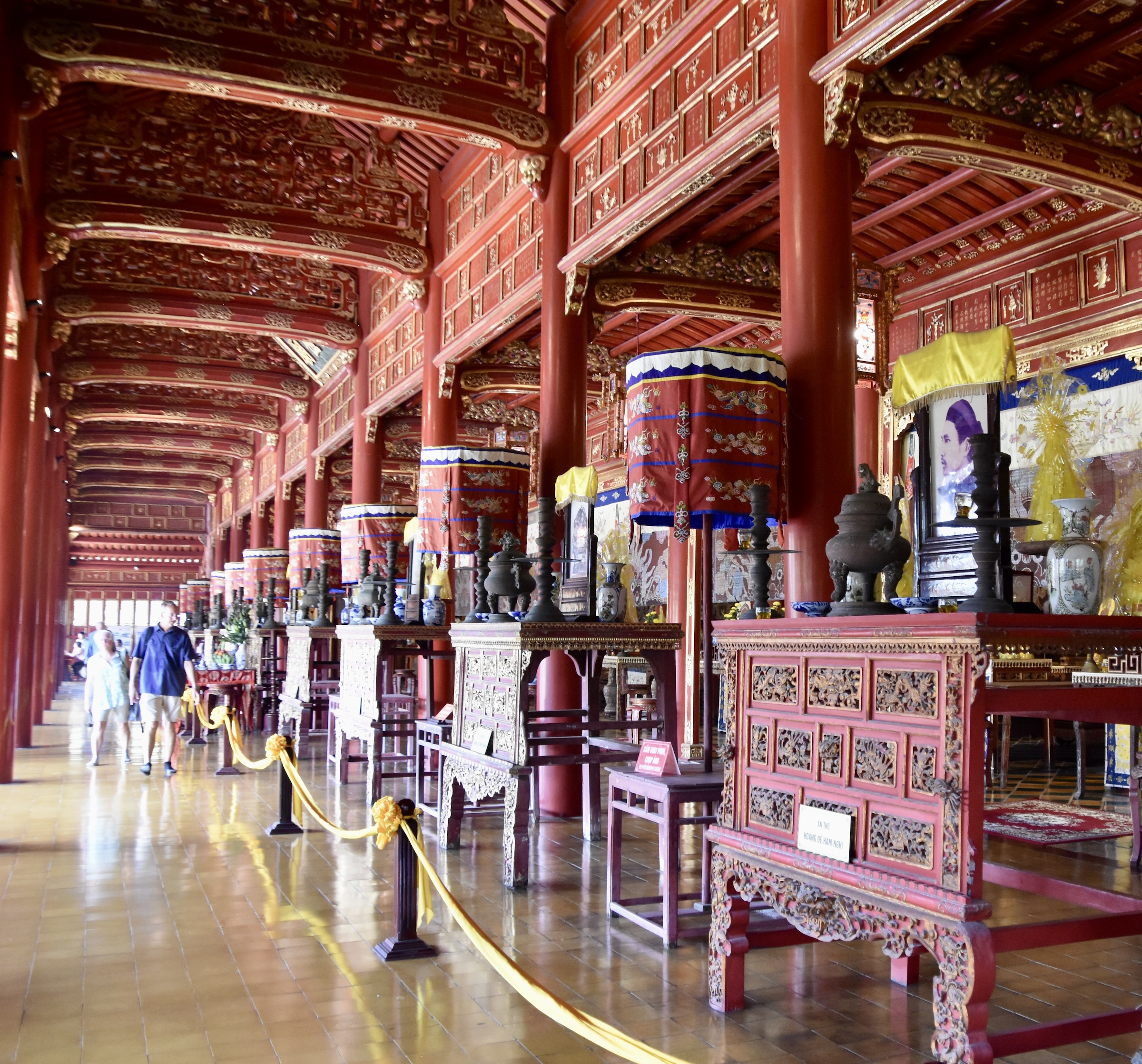
You exit this area of the Imperial City in Hue through this gate.
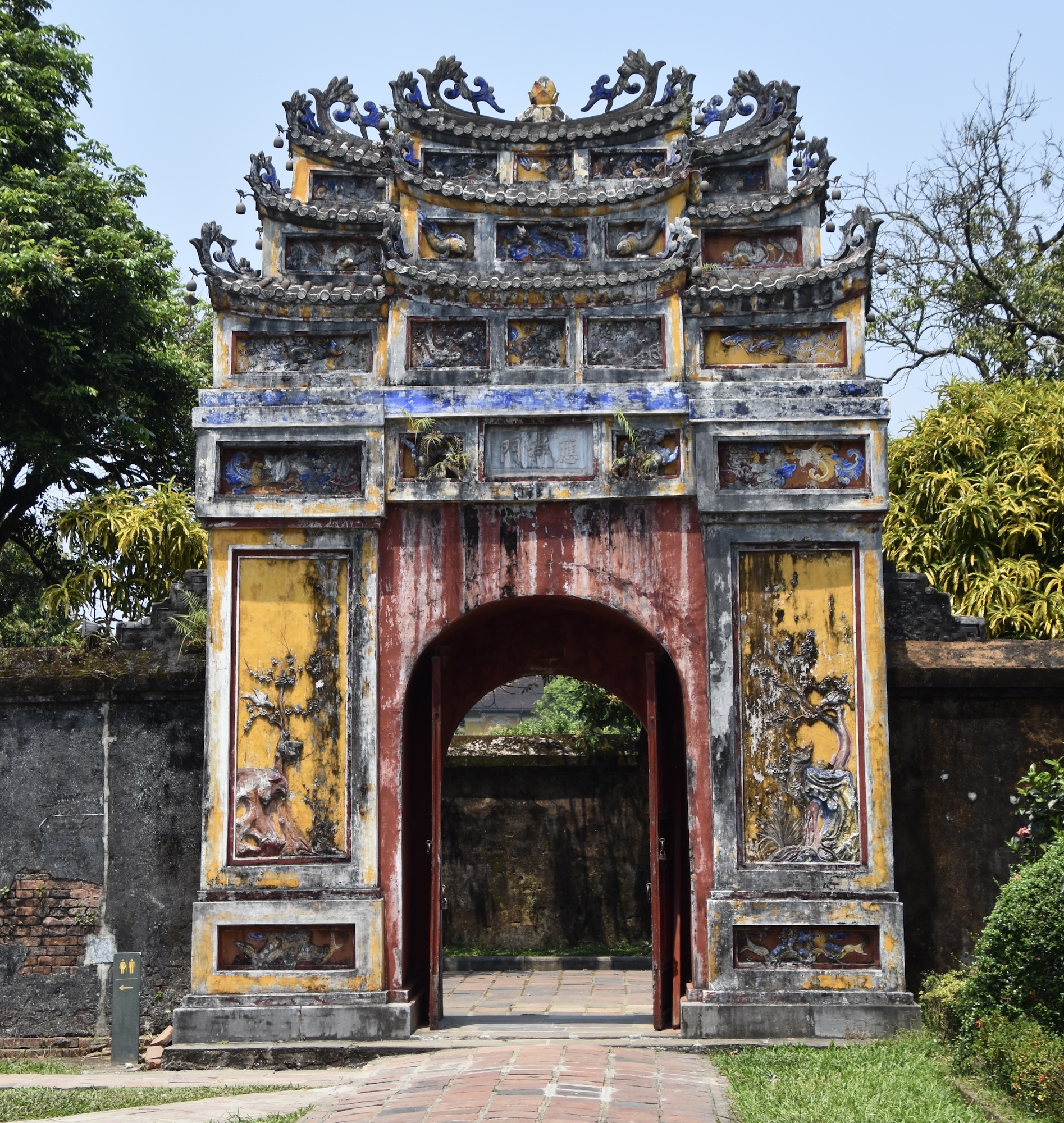
One of the most impressive of the remaining buildings in the Hue Citadel is the two story Reading Room aka the library.
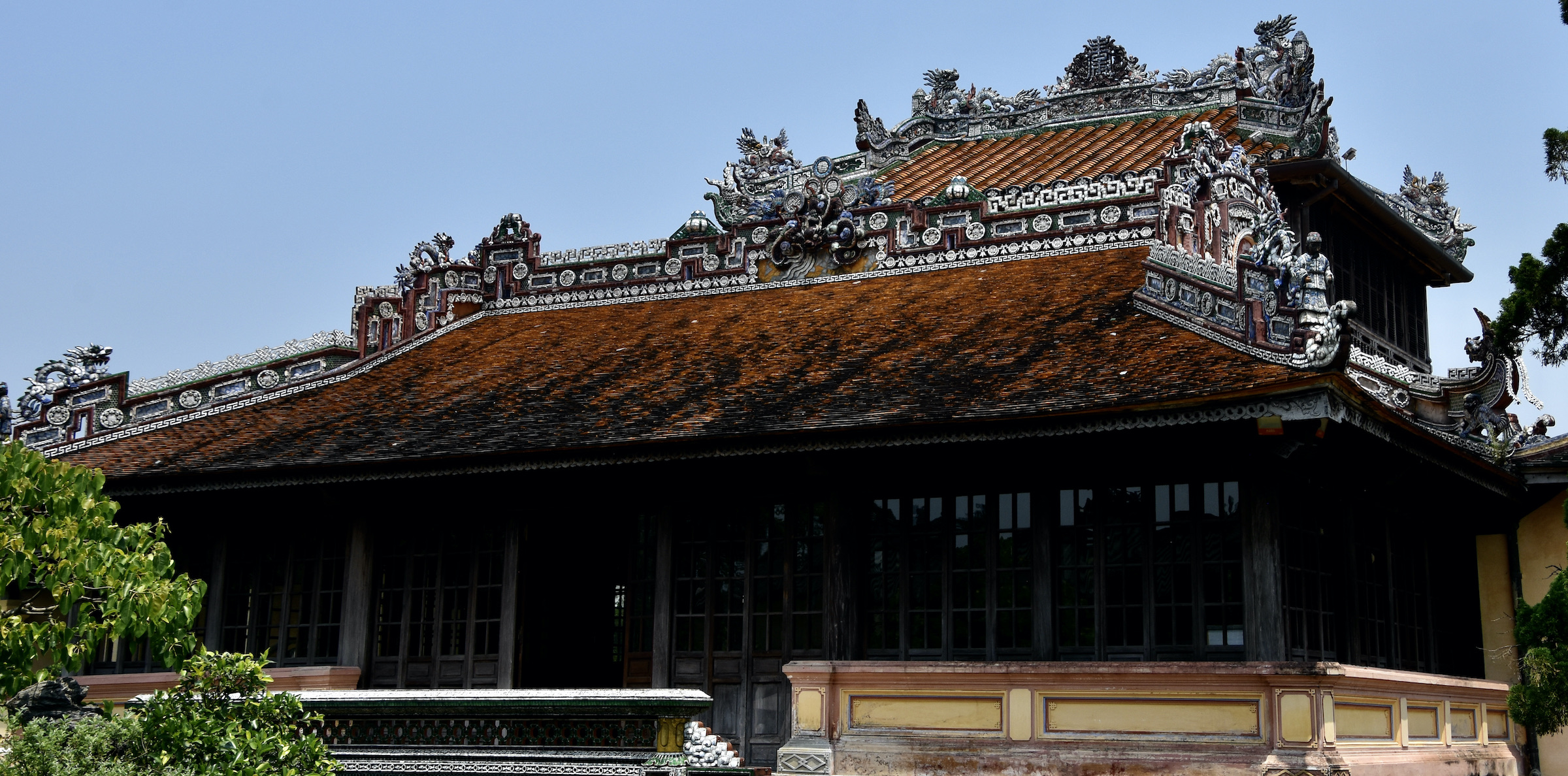
This is a portion the interior.
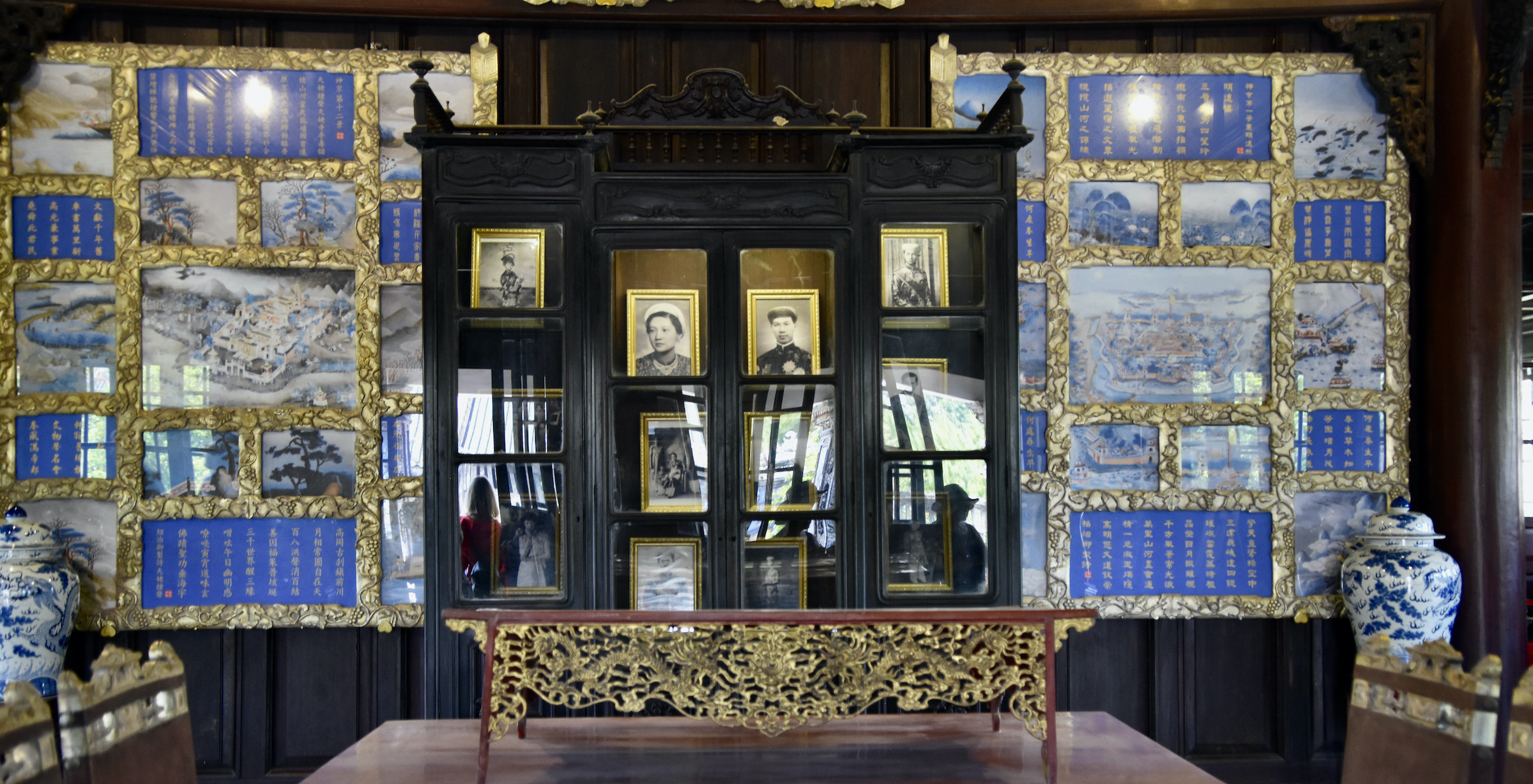
The largest and most impressive building in the Hue citadel is the Dien Tho Palace which once housed the Emperor’s mother and grandmother.
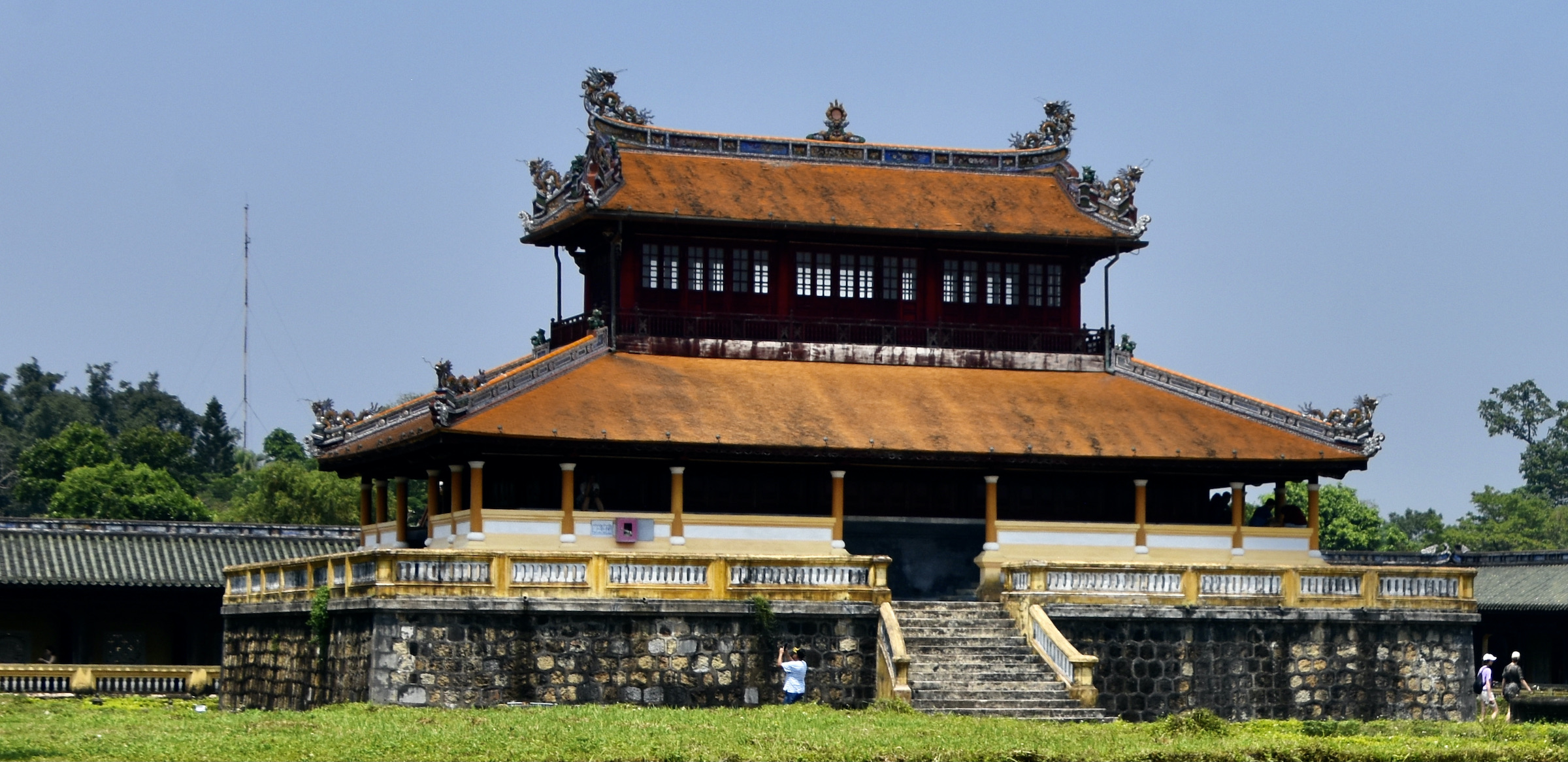
The most intricate building at Hue Citadel is the last that we will visit on this tour. This is the Theatre, built in 1826 for the exclusive use of the royal family and their patrons. Here they would view classic Vietnamese dramas.
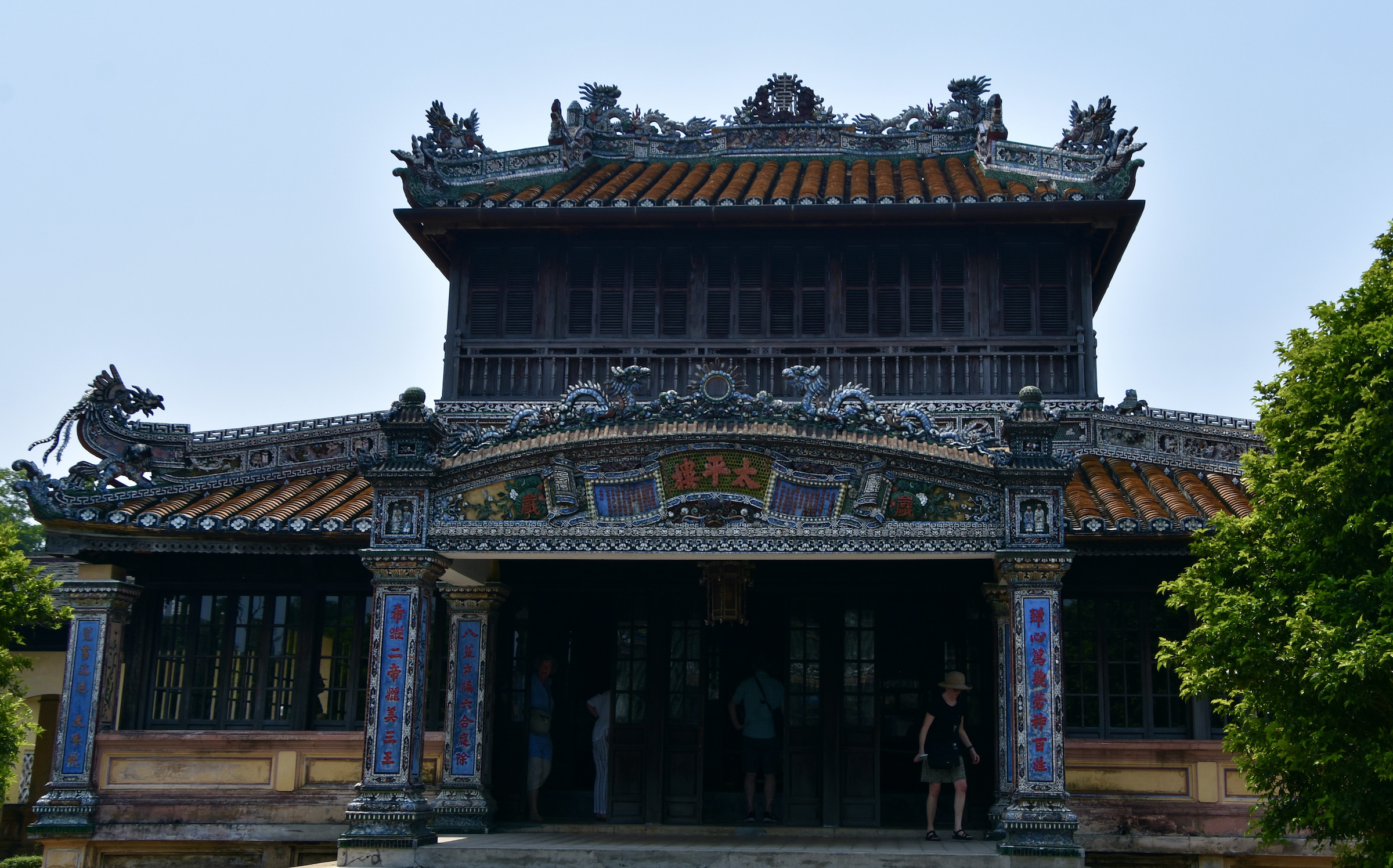
The interior is as ornate as any of the great theatres built in Europe around the same time.
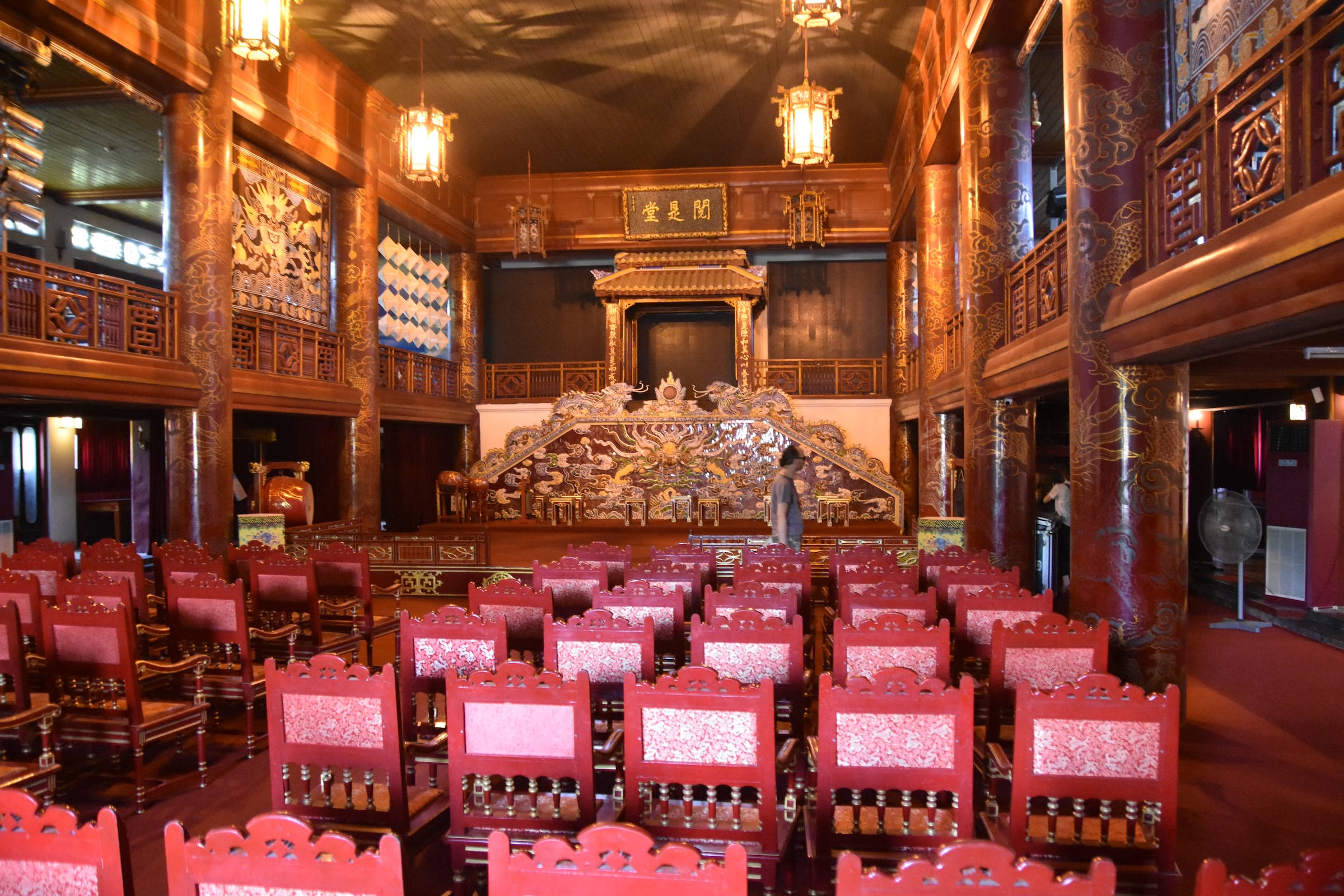
We say goodbye to the Hue Citadel as we pass through this gate.
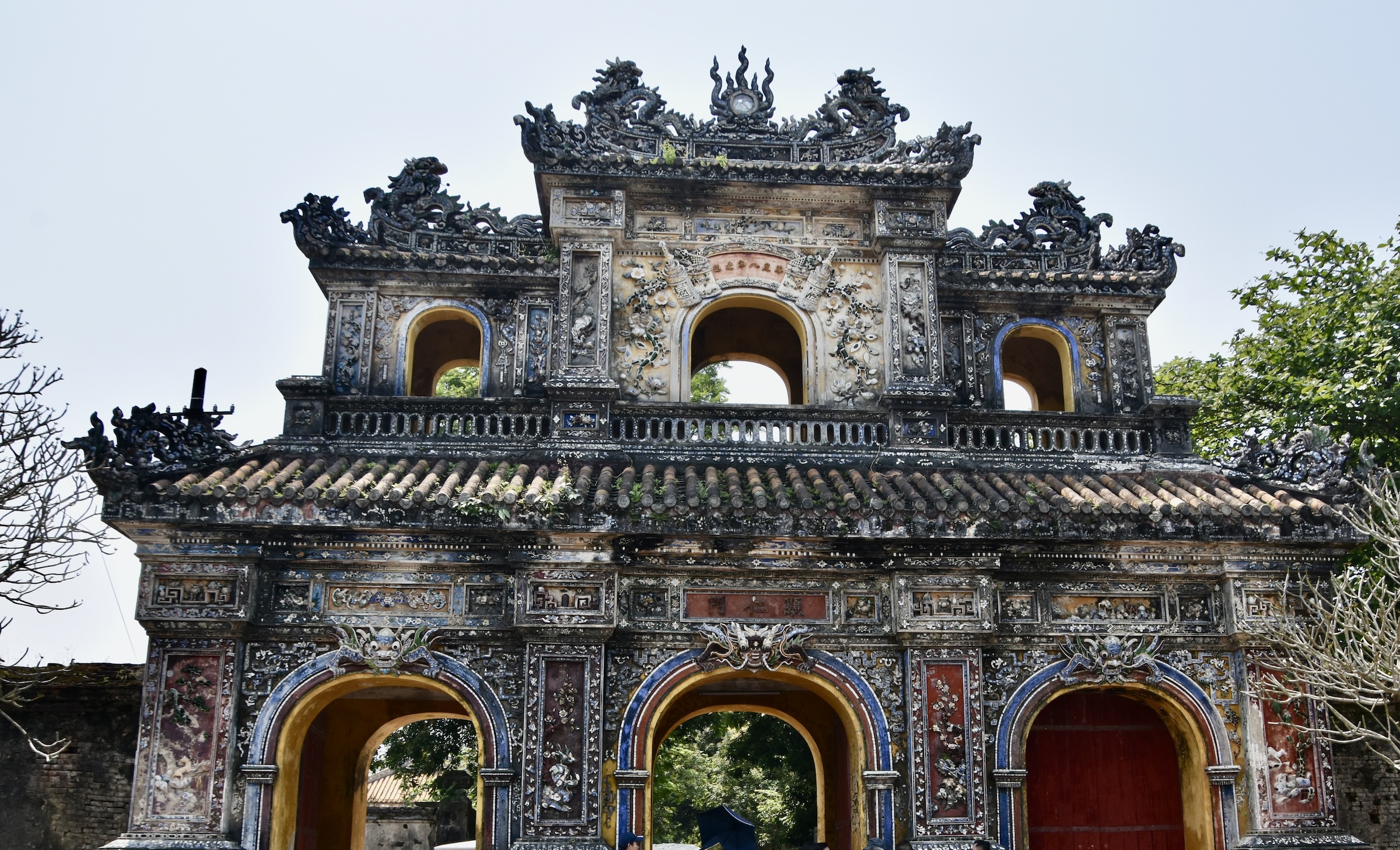
I can only imagine how majestic this entire complex must have looked from viewing the few remaining buildings and once again reflect on the folly of war, knowing that it continues today as Russia decimates one Ukrainian city after another.
This concludes our visit to central Vietnam which has revealed three UNESCO World Heritage Sites, great food and great company. Tomorrow we will enter the final stretch as we fly to Saigon, a city I have long wanted to see. I hope you’ll join us.
Oh, and before I forget, Alison liked the Hue Forbidden City more than it’s more famous predecessor in Beijing.

